#are like all the descendants/parts of the ancient north eurasians
Explore tagged Tumblr posts
Text
"raza" is actually referring to the coming american race (the cosmic race, some might say)
#they just don't know it yet#50 years from now you'll have totally white/anglo looking people#with hispanic last names#who have a technically legitimate claim to being part of the “raza”#just look at intermarriage rates between whites and latinos#i suspect within the next hundred years mestizos will basically be looked at as#america's equivalent of southern europeans#also i don't know how it is in other parts of the country#but here in california there's also a pretty significant number of eurasians/hapas#they're interesting -- i think they are an underdiscussed part of the coming american race#they are frequently high iq and high achieving and part of the elite class#and they seem to be welcomed as “white americans” pretty seamlessly#for the most part anyway -- of course i've heard stories of some really racist white people that don't accept them#but even my hometown has a very white-eurasian upper class#lol one of my last “crushes” was this hapa girl and she was the daughter of some business executive millionaire guy#who was very active in local politics#he was very waspy#and she was mostly white passing#like you could kinda tell she had some asian in her but it wasn't super obvious#she was kinda ethnically ambiguous -- central asian looking#but anyway i just think it's funny#that the races that are most common and most likely to intermarry (whites + asians and whites + hispanics)#are like all the descendants/parts of the ancient north eurasians#and i just think it would be funny if we recreated them
5 notes
·
View notes
Text
''Findings: MtDNA Kurds matrilineal aboriginals represent mother-clans, who substantially co-founded Near East (Eurasia/ West Asia) and Europe. Comas et al. 2000 summarized: “Almost all Kurdish sequences belong to the quite homogeneous European/West Asian mtDNA sequence pool”. Richards et al. (2000) detected very old “U5 lineages, although rare elsewhere in the Near East, [...] especially concentrated in the Kurds, Armenians, and Azeris” as well as “substantial back-migration from Europe into the Near East of mtDNA lineages”. Comas et al. (2000) concluded: “They [Kurds] may represent the descendants of the first shepherds that occupied the Kurdistan highlands since the first Neolithic”.
J-men ancestors point to (first) Neolithic Northern Fertile Crescent farmers and shepherds forefathers of Kurds, and at the same time indicate the closest genetic relationship between Kurds, and Jews (and in a wider range also including Armenians) ever measured so far.
Conclusions of cited authors: Nebel et al. (2001): “Jews were found to be more closely related to groups in the north of the Fertile Crescent (Kurds, Turks, and Armenians) than to their Arab neighbours.” [Turks = Anatolians in Turkey of today]. The Armenian DNA Genealogist Levon Yepiskoposyan agrees: “Our data confirm the results of other researchers and indicate that Jews, Armenians, and Kurds belong to indigenous Near East and Anatolian populations who were the founders of the European and Middle East civilisations.”
This data indicate, that Kurdish descendants (speakers of the “Kurdish Complex”), who are still living in large numbers on ancient Hurrian-Mitanni soil, show the highest ever measured ethno-genetic percentages of R1a1 men ancestors in Eurasia. If it holds, that migrating (militarily organized) elites of R1a1 clanmen were also involved in linguistic processes of Indo-Europeanizations in ancient Anatolia and Hurri-Mitanni areas as early as 2240-1140 B.C. from South Russia, ancestors of Kurds (speakers of the “Kurdish Complex”) could have been substantially involved.
…analysis provide strong indications that both ethnic forefathers of Kurds as well as ancestors of linguistic speakers of the “Kurdish Complex” have existed in their ancestral Eurasian homeland already B.C.E. Valuable historic pieces of information were contributed by findings both of Palaeo/Archaeo-Genetics and DNA-Genealogy. By that, it was above all possible to outline a traditional aborigine ancestral habitat of Kurds (speakers of the “Kurdish Complex”) geographically for the main parts located in a wider Eurasian Northwest, largely outside and northwest of Iran of today. Ethno-genetically, it could be shown, that Kurds derived obviously out of a broader, pre-IE multi-cultural substratum of the Near East and Eurasia, and were in early ancient layers predominantly shaped by first Neolithic Northern Fertile Crescent farmer and shepherd aborigines. Genetically, they seem to be close related to other Near East and Eurasia substratum aborigines like Jews and Armenians.'' (Nebel et al. & L. Yepiskoposyan).
1 note
·
View note
Text
This post is my attempt to simplify what I learned from Who We Are And How We Got Here into a timeline I have a shot of remembering for years, with some padding from Wikipedia where I thought it would help me.
---
As a backdrop to the specifics that follow: humans and human cousins have been sort of ambling out of Africa and back in waves of migration and interbreeding and extinction, for the past two million years.
Around 650K years ago, humans split from the group that will further split 200K years later into Neanderthals and Denisovans. These are the two 'archaic human' populations that contributed some genetic material to modern humans, whose DNA we got our hands on. This is also maybe the divergence point of humans and another archaic population in Africa that later mixed back into humans, that we don’t have DNA evidence for.
200K years ago, zoom in on the ambling in and out of Africa, because now some of the ambling groups are what we’d call anatomically modern humans – that is, their phenotypes fit within existing human populations. At this point, the split between the San population (the most different-from-everyone-else population alive today, whose descendants currently live in South Africa) and the rest of living humanity begins.
50K years ago, a period of great interest. We see behavioral modernity starting hereish, at the beginning of a period (lasting ~40K years) we call the Upper Paleolithic. The rate of stone toolmaking innovation speeds up from ‘glacial’ to ‘every few thousand years’. (If that seem like an odd setting change, I agree.) We see the first known jewelry and representational art. Likely we’ll never have a satisfactory explanation of what exactly changed. We almost certainly had language by this point.
Human colonization of Australia and New Guinea happens, while ocean levels are low. This is part of a radiation of a hunter-gatherer lineage spreading out all over Asia. Some of them will eventually go to Siberia and the Americas. Some of them will become the Yangtze River population and some the Yellow River population, who will later mix to produce the majority of mainland East Asians.
40K years ago. After several thousands of years of contact with modern humans, Neanderthals and some other branches more closely related to modern humans go extinct. There’s an Italian supervolcano eruption nowabouts whose climate disruptions in Europe may have intensified competition.
One thing this book has taught me is that it’s misleading to talk about ‘population splits’ outside of the Americas, because lineages diverged and met again many times, but insofar as it’s meaningful to talk about when the European and East Asian lineages diverged, it’s now.
30K years ago. The archaic humans in Africa mix back with humans and contribute 2% of ancestry to some modern African populations.
Around this time, there exists a population called Ancient North Eurasians. Some of them go east, and contribute to the population that will give rise to Native Americans (who are ~1/3 Ancient North Eurasian, ~2/3 ancestors-of-East-Asians). Some of the rest will remain and contribute ancestry to various Eurasian hunter gatherers, as well half the ancestry of the Yamnaya people of the Eurasian steppe, who will later invent horse-and-wagon way of life and become massively successful in Europe.
15K years ago, there are two migrations to America over the Bering land bridge: (1) The First Americans (the Ancient North Eurasian - East Asian group) account for the majority of Native American ancestry. These newcomers quickly zoom through the Americas. They also may have had a startlingly small effective population size – like 250. (2) A mysterious population that contributes some ancestry to a handful of groups in the Amazon, a population whose closest known descendants today are, intriguingly, Australasian. We don’t know much about them.
10K years ago, agriculture arises in the Middle East. Some Anatolian farmers spread out into Europe. Some Iranian farmers spread out to India. A thousand years later, agriculture also begins in China, in the Yangtze River and Yellow River populations.
5K years ago. The horse-and-wagon Yamnaya sweep from the eastern European steppe into northern Europe and largely replace the population there, and account for 25~45% of current European ancestry. The Yamnaya culture is the strongest candidate for the source of the Proto-Indo-European language (which has an elaborate shared vocabulary for wagon-parts). A large part of their success may have been that they were relatively immune to diseases that the rest of Europe was not – they brought plague with them, heretofore unknown to Europe. With the Yamnaya, the Bronze Age; we have evidence of much more social inequality than ever seen before, evident both from archeology and genetics, which tell us that the highest-reproducing individual men starting now are more reproductively successful than ever before.
Around the same time, there’s another wave of migration from Asia to North America – the Paleo-Eskimo lineage – that leaves a ~30% imprint in some parts of North America. The Paleo-Eskimos will be displaced 4K years later by a final wave from Asia, the Neo-Eskimos, who are the ancestors of modern day Inuits.
The Yangtze and Yellow River populations are also spreading out nowish. Their collision produces much of modern East Asians. The Yellow River people are associated with the Han, and the Tibetans. The Yangtze population, where they spread south, provides much of modern Southeast Asian ancestry.
4K years ago, the Indus Valley civilization is hit by a wave of migration for Europeish, by a steppe people who bring Proto-Indo-European culture and language. These steppe people are about half Yamnaya-related, and half ‘the Iranian farmer related populations the steppe people encountered on their way south’. The natives are about three quarters local hunter-gatherers, and one quarter Iranian farmers who mingled in ~2K years earlier. The natives and Yamnaya-ish migrants mix over the next 2K years to form a modern Indian population that’s a mixture of the two, ranging from 80% Yamnaya-ish (especially in the north, and in higher-caste groups) to 20%.
Around now, the first of four great migrations and mixing events of Africa starts – most significant among them is the Bantu migration south, out of Nigeria and into west-central Africa. Most of the present-day population structure of Africa is shaped by these relatively recent expansions, making it hard to tease out ancient splits.
267 notes
·
View notes
Text
A World of Dinosauroids
C. M. Kosemen with Simon Roy
My post on Simon Roy’s “Dinosauroids” is one of the most reblogged things on this blog. I love the concept because it rewrites the cosmic tragedy of the K-T Mass Extinction Event, resurrecting dinosaurs and projecting their continued evolution in ancient world that is alien but also eerily resonant. Recently Simon turned me onto The-Master-Post-on-All-Things-Dinosauroid on his long-time collaborator, C. M. Kosemen’s, site. The following post has been transcribed from C. M. Kosemen’s blog and formatted for Tumblr with @simon-roy‘s blessing.
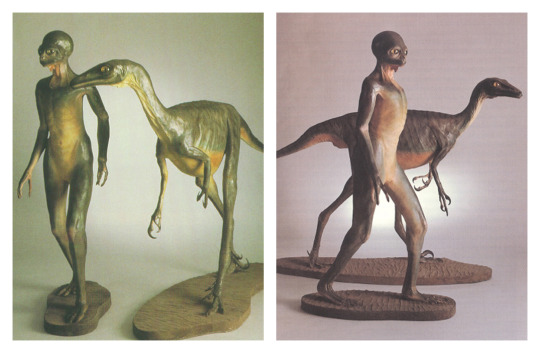
There are two highly-popular, vexing questions about dinosaurs: What would the world look like if these strange and majestic animals had not gone extinct? And, would they ever evolve into intelligent species comparable to humans? In 1982, palaeontologist Dale Russell, after observing “… a general trend toward larger relative brain size in terrestrial vertebrates through geologic time, and the energetic efficiency of an upright posture in slow-moving, bipedal animals”, postulated the Dinosauroid, a humanoid, erect-gaited sophont which may have evolved from Troodon-like dinosaurs had the end-Cretaceous extinction not occurred.

This question occupied the minds of yours truly (seen here on the right), and world-building comic genius Simon Roy (on the left), as well. We were unconvinced by Russell’s Dinosauroid. We thought that an erect, humanoid sophont was too prejudiced towards humans to be realistic. We were instead inspired by zoologist Darren Naish’s writings on the evolution of intelligent, bird-like dinosaurs: “No, post-Cretaceous maniraptorans wouldn’t end up looking like scaly tridactyl plantigrade humanoids with erect tailless bodies. They would be decked out with feathers and brightly coloured skin ornaments; have nice normal horizontal bodies and digitigrade feet; long, hard, powerful jaws; stride around on the savannah kicking the shit out of little mammals; and in the evenings they would stand together in the trees, booming out a duet of du du du-du, a deep noise that would reverberate for miles around…”
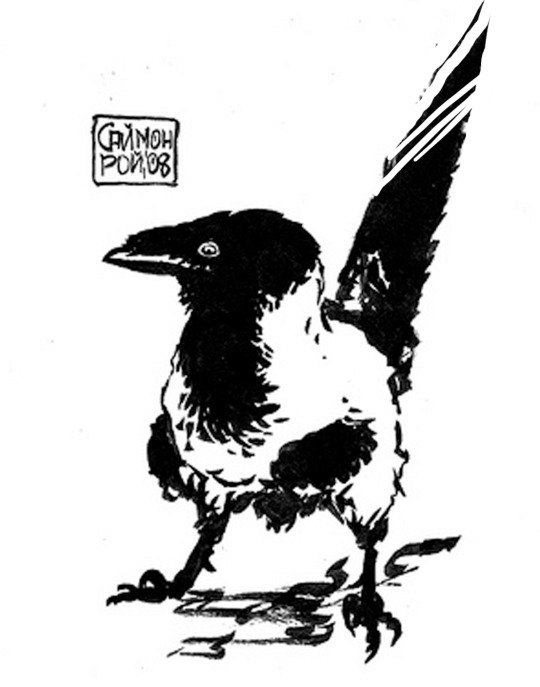
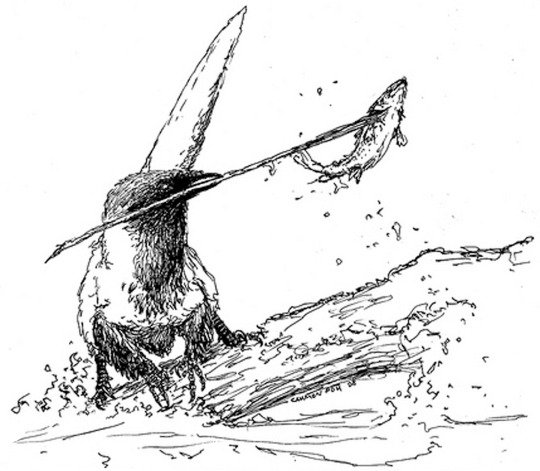
Towards the end of the ‘00s, Simon Roy and I independently began to develop our concepts for bird-like intelligent dinosaurs. Inspired by the ravens he saw around his Canadian home, Simon drew the corvid-like dinosauroids seen above.
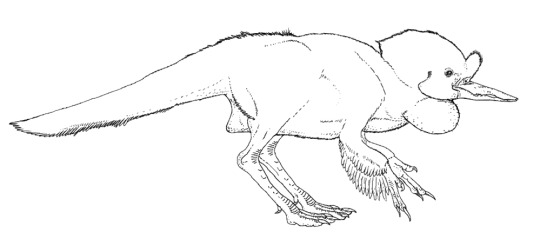
I, in turn, was inspired by ground hornbills, parrots, certain dinosaurs and corvids, and came up with the speculative organism seen above. I named it Avisapiens saurotheos. Simon and I soon got in touch with each other; and started developing a world and a storyline for our dinosauroids. Our collaborative efforts continued, on-and-off, until the mid-2010s. Our aim was to develop the Dinosauroids story into an illustrated story-book, which we naively hoped to sell to a major sci-fi publisher. But we soon realised that we enjoyed world-building more than writing a story, or putting a book together. We kept bouncing concepts back and forth, but never had a chance to publish them, until now. Most of the body of work you see on this page was drawn by Simon, based on ideas we created together. I also contributed some of the “cave drawings” and certain creature illustrations. This is the first time the totality of our Dinosauroids-universe works has been displayed online.
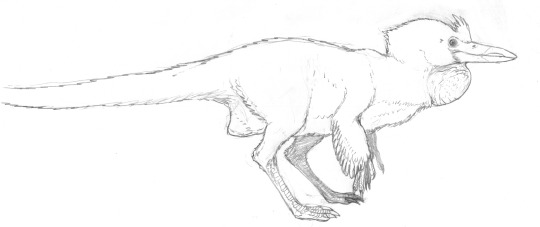
Simon and I refined the design of my original Avisapiens dinosauroid…
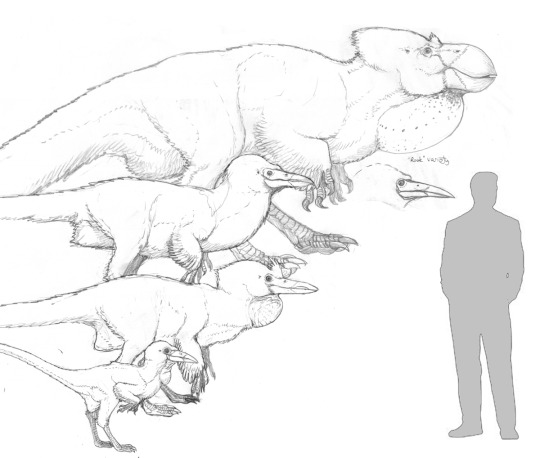
And created a few more sentient races to accompany them. There was one more, slightly-crow-like species of Avisapiens (a continuation of Simon’s corvid dinosauroids - Avisapiens tataricus). These two species were joined by a variety of “forest giants” (Gigantosapiens borealis), and a race of pygmies (Avisapiens minimus).
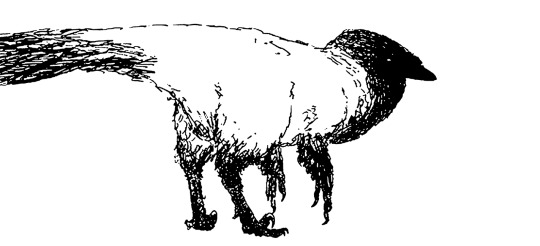
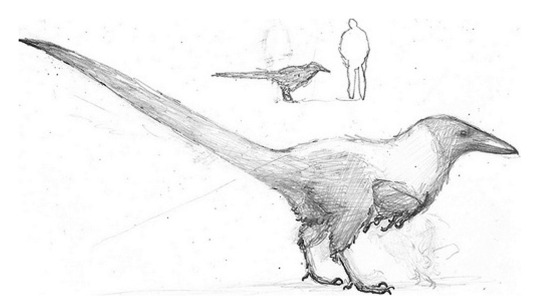

Simon’s refined studies of corvid-like, and pygmy dinosauroids.
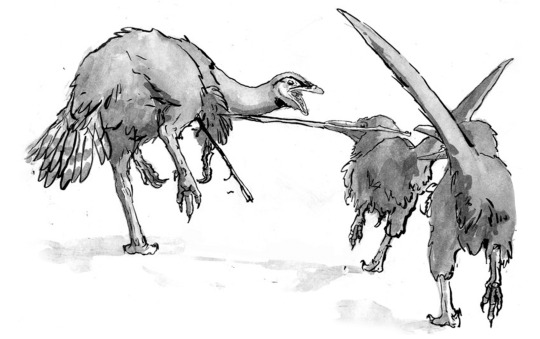
We also designed an extensive selection of animals around our dinosauroids. We predicted that even without the K/T mass extinction, dinosaurs and other animals would have kept on evolving, and many “familiar” groups of dinosaurs would have gone extinct. We thus designed a world where the majority of surviving dinosaurs were the descendants of “maniraptoran” groups; birds, deinonychosaur (“raptor”) dinosaurs, troodonts, oviraptors and therizinosaurs. Here, you can see two boreal dinosauroids using mouth-spears to hunt herbivorous troodont quarry.
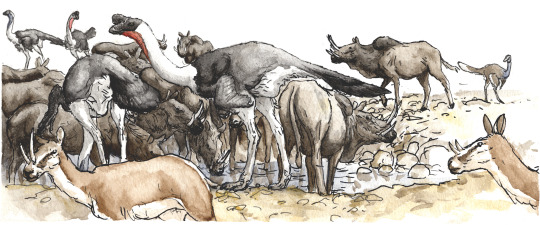
We also did not want this world to be devoid of mammals. Even during the age of dinosaurs, certain mammals evolved into large and sophisticated forms. We envisioned a world where parallel groups of mammals, similar to, but phylogenetically distinct from today’s forms, co-evolved alongside the dinosaurs during their continued reign. The scene above shows an Eurasian water-hole crowded with two species of ornithomimid herbivores (Rugocursor, left-centre; and Cyanogularia, far right); alongside robust (Afrotuberculocamelus) and gracile (Odontocervoides) species of herbivorous mammals which, for the lack of a better term, we decided to name “supermaras”.
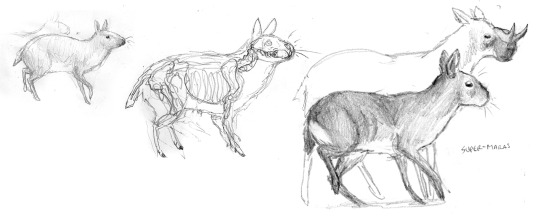
A series of studies showing the evolution of supermaras from rodent-like multituberculate mammals. The species depicted here is Ceratomegamys.
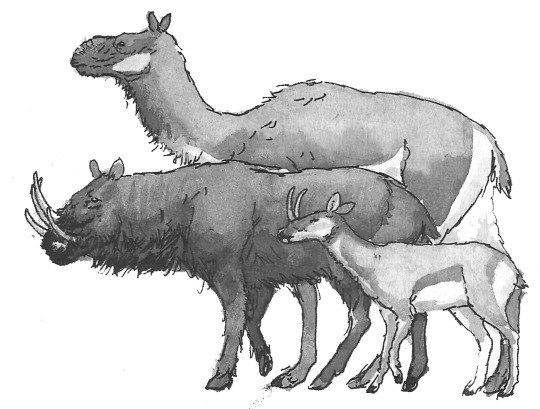
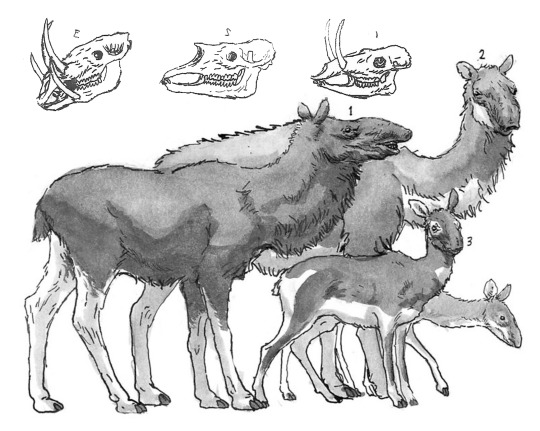
The full diversity of cursorial “supermaras”, from left to right: The burly, tusked Odontobovis; the superficially-camel-like Tuberculocamelus; the gazelle-like Odontocervoides; the trunked, moose-like Pseudalces; and the two related forms - the big, desert-dwelling Macropseudalces; and one of the many deer-like Cervopseudalces species.

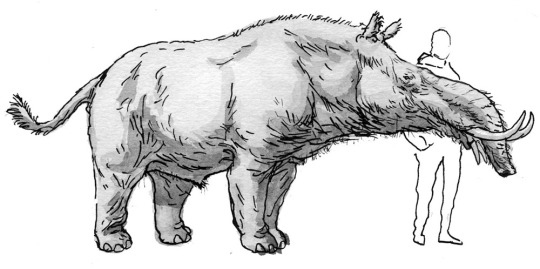
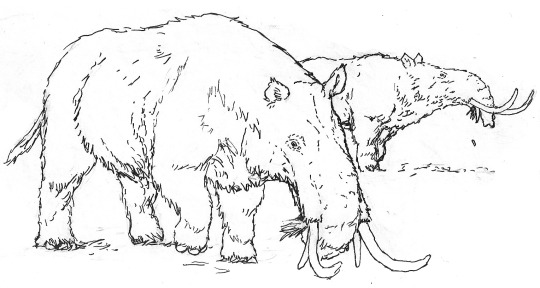
Studies of Megatapirus, large, superficially-elephant-like mammals that live in far-northern climates.
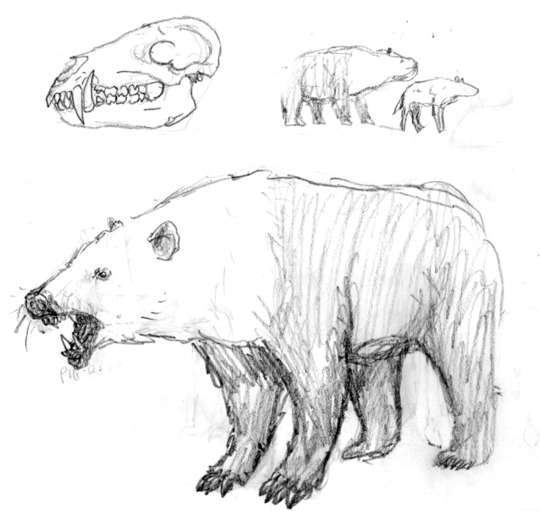
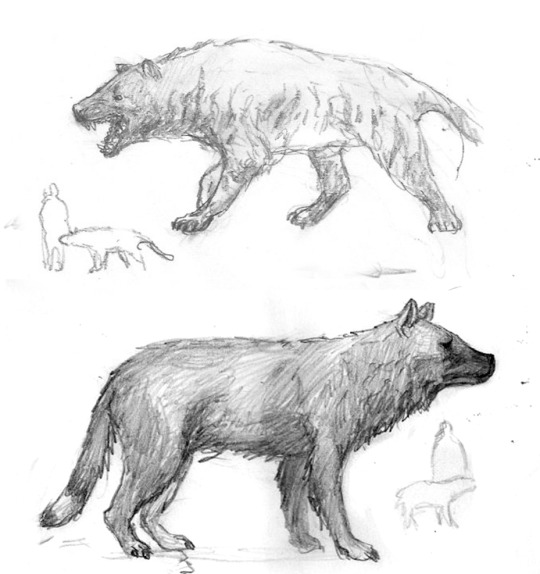
We also derived a variety of mammalian carnivores, mostly from marsupial stock. Through the honing forces of evolution, we imagined some would look very similar to the canid predators we have in the present day - the actual difference would only be in their internal and reproductive anatomies. Above, clockwise: The large, badger-like Mephitursoides; the extremely dog-like Pseudokynos; the hyena-like Krokutadasyurus.
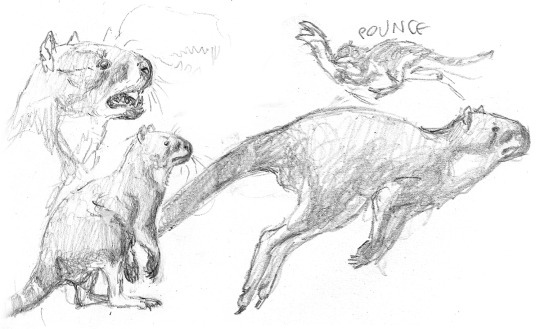
Some marsupial predators diverged from the mammalian body-plan, and evolved into forms roughly converging with the predatory dinosaurs. The raptorial, meat-eating kangaroo-equivalent Theropodoktonos and kin are potent predators in South America.
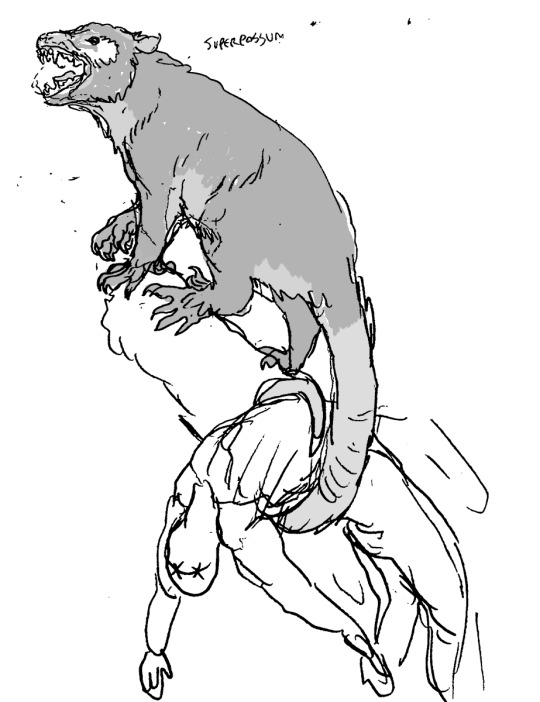
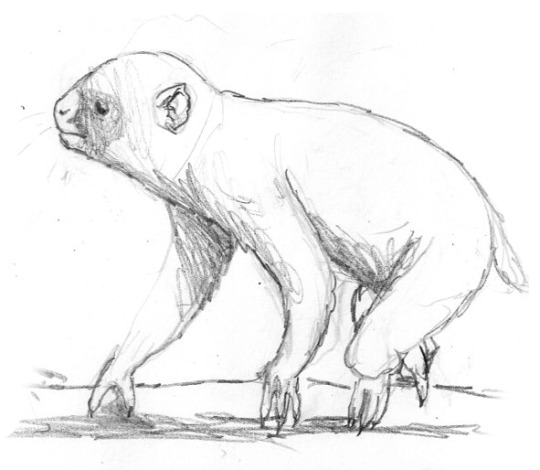
Two more divergent marsupials: The leopard/possum Phobodidelphyoides; and the monkey-like Marsupiolemuris, a social, arboreal form with a potential to evolve intelligence.

We also wanted to have flying reptiles - pterosaurs - still alive and kicking in our world. These extraordinary animals were already in decline by the time dinosaurs became extinct. So we relegated them to only a few roles, comparable to storks and other large water-birds alive today. Above is a flock of Diluvipterus; large, filter-feeding pterosaurs. Also note the solitary duck flying on the upper-left corner.
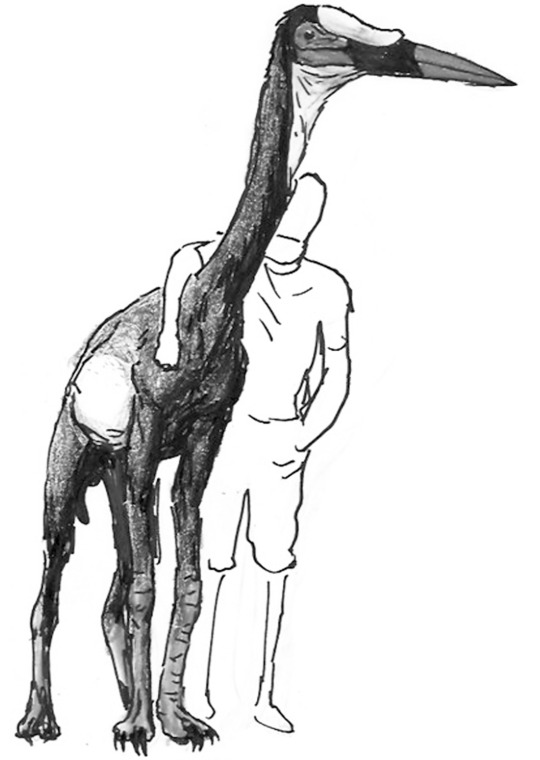
Another, flightless pterosaur, Cygnotherium, from the islands that now make up New Zealand.


A more unusual group are the avisuchians, descendants of maniraptoran dinosaurs that secondarily converged on the aquatic bodyplans of spinosaurs (which are now extinct in this timeline). Most resembled the short-tailed forms, Pisciraptor and Brachyornithoides seen above. These goose-to-dog-sized animals inhabit rivers and lakes, and occupied a niche comparable to otters today.
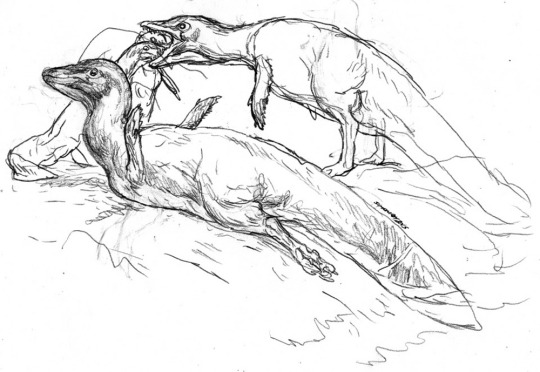
There were also long-tailed Avisuchians such as the Natatoraptor seen above. These animals inhabit open waters, and nested in estuaries and beaches.

A contemporary scene from Eurasia shows commensal life between mammals and dinosaurs. Two Pseudalces browse peacefully alongside two kinds of large ornithominids, Archganseria and Brontonyx. A tiny, heron-like troodont, Anatolocursor, can be seen between them, looking for small animals flushed out by the large herbivores’ movements.

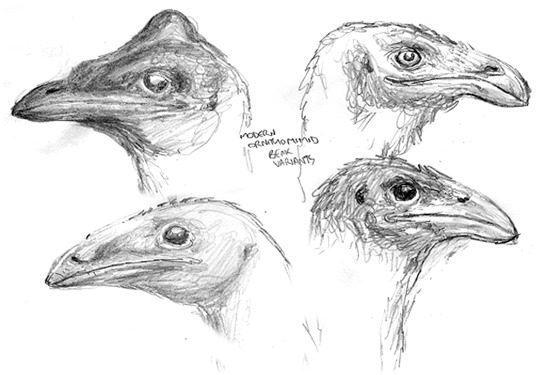
Nevertheless, despite co-existing with large mammals, dinosaurs are more diverse on this world. Herbivorous dinosaurs, such as these derived ornithomimids, constitute a large part of dinosaurian diversity. Above left are studies of Ganseria, a common, medium-sized browser. Above right, clockwise from the top right, are portraits of Ukkuloganser, another medium-sized browser; Nyctodromon, a nocturnal digger; Adzuganser, a small omnivore; and Pyramidoganser, a crested form native to the Nile Delta.
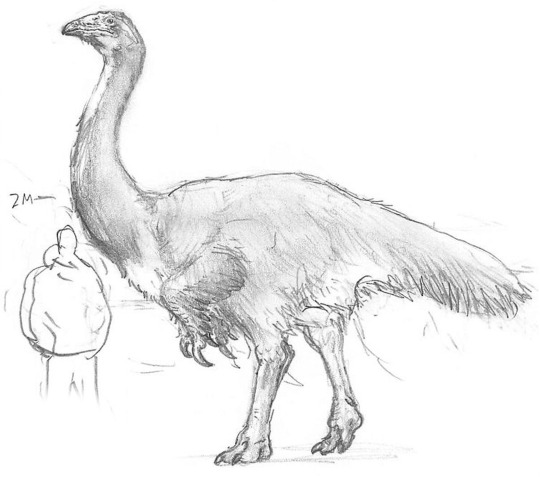
A scaled study of Brontonyx, a heavyweight ornithomimid herbivore.
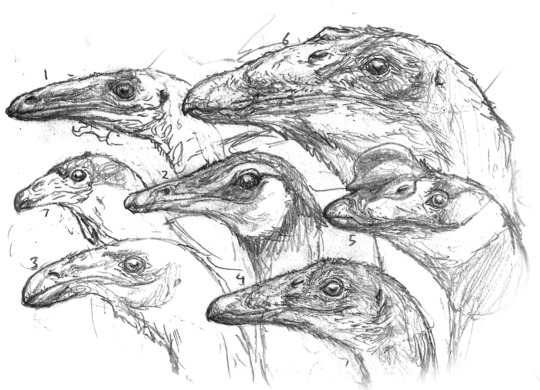
Portraits of many cursorial dinosaurs from across Eurasia: 1- Leptoganseria, a mountain-dwelling ornithomimid browser found on the mountains of what is now the Caucaus. 2- Ikiridectes, a troodont that mostly hunts small digging mammals. 3- Aktardektes, a small ornithomimid that has specialised for cracking hard-shelled nuts. 4- The gracile, juvenile variant of Brontonyx, (6) which occupies a completely-different ecological niche as a generalist omnivore. 5- Rugocursor, a widespread, broad-beaked ornithomimid with many species, common across North Africa and Eurasia. 6- The adult form of Brontonyx, a gigantic ornithomimid that feeds on trees, and defends itself with heavy claws. 7- A vulture-like Cynornithoides, an extremely bird-like troodont, a frequent commensal of Avisapiens and related intelligent species.
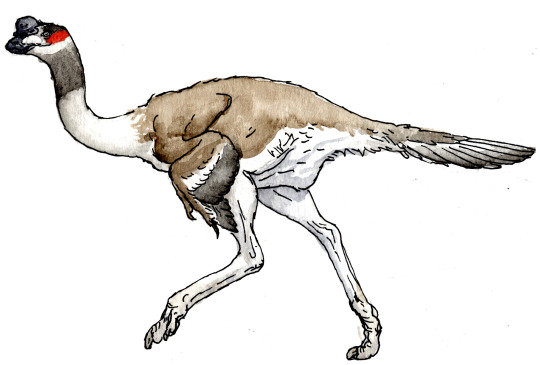
A variety of Rugocursor, a mostly-herbivorous ornithomimid with adaptations for running.
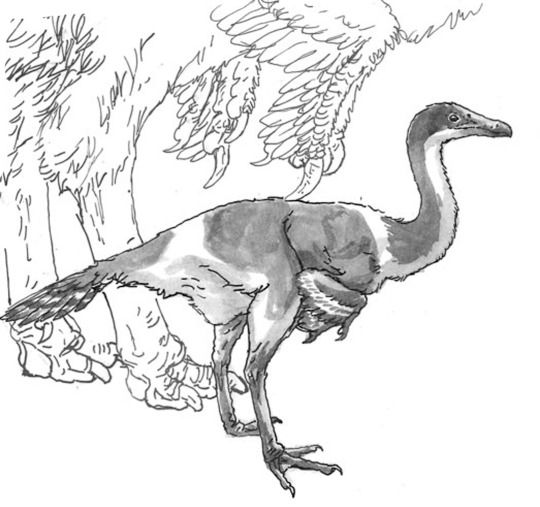
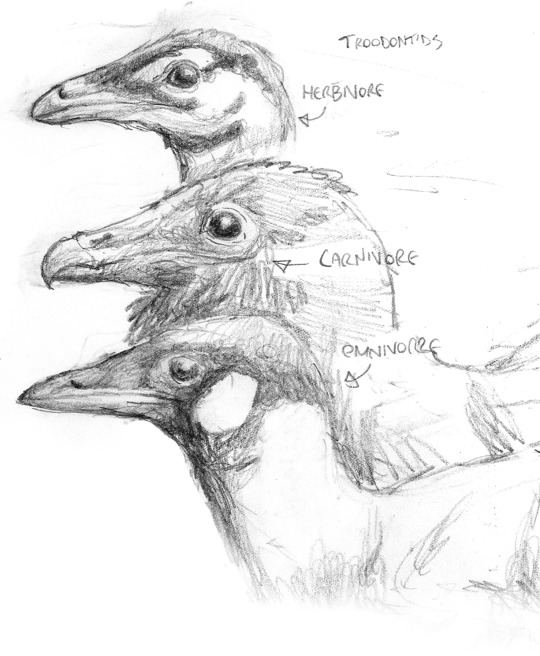
Various troodonts, small-bodied, sometimes very bird-like omnivorous dinosaurs, distantly related to the Avisapiens lineage. Left, shaded study of Variocursor, a common, heron-sized, striding predator on small animals. Right, from top to bottom; Vuuria, a herbivorous form common across Eurasia; Boreocursor, a cold-climate predator, related to the Variocursor seen on the left; and Paravuuria, an omnivorous form.
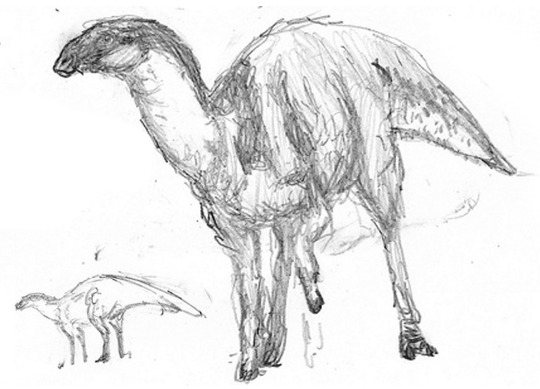

The last descendants of hadrosaurs, the famous “duck-billed dinosaurs”, still roam in South America. The hoofed, sheep-sized Ornimastax seen above left, is a typical example. Australia, as in our world, is home to an unusual radiation of forms whose relations to animals on other continents are not very clear. Brachygullagong, seen above right, is a troodont-like form whose duck-like skull and batteries of grinding cheek teeth have secondarily converged with those of the hadrosaurs.

The largest herbivores on this world are long-necked, scythe-clawed ornithomimid relatives known as avititans. The largest species on Eurasia is Avititan bicolor, seen above in scale with a human figure.
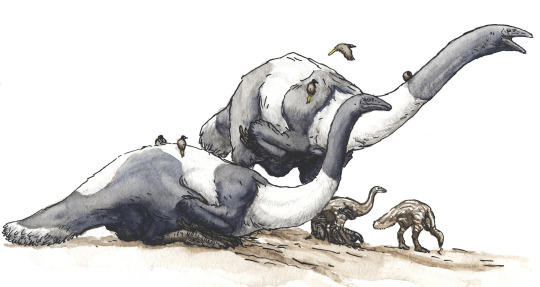
Avititans owe their ecological success to their strong social structures and their care of their young. Here are two Eurasian avititans with their offspring. Yellow-tailed enantiornithine tick-birds, Parasitophagus leucurus, can be seen on their backs.
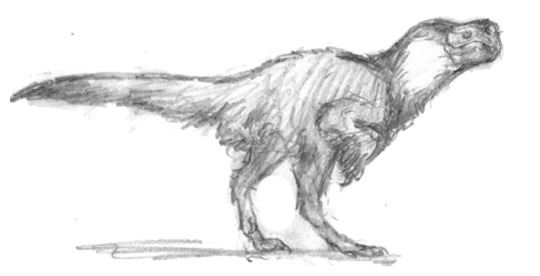
Oviraptoriformes made up another important clade of dinosaurs in this world.

Descended from bird-like ancestors, various clades of these animals live on as important omnivores, scavengers and even predators in many ecological niches. Above is Eblisornis, a common species found throughout Eurasia.
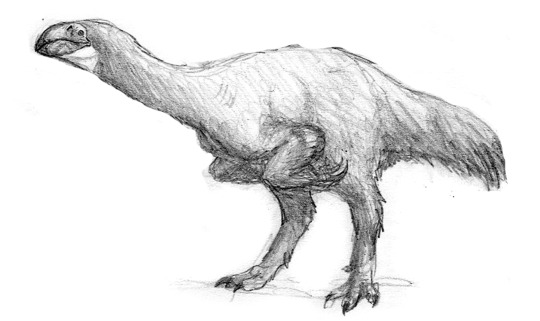
The bull-bird, Bosornithoides erythrops, is the largest and most prominent oviraptoriform on the Eurasian continent. It subsists mostly on plants and fruit, but will eat carrion if given the chance.
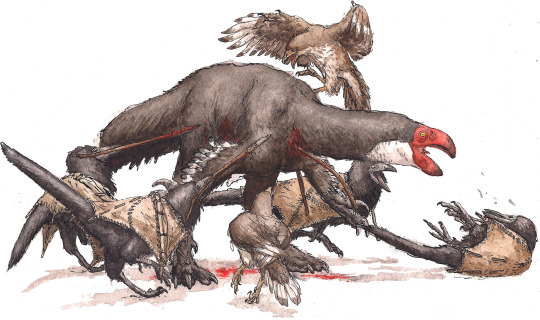
Hunting the wary and dangerous Bosornithoides is an important rite of passage for dinosauroids. The animals require coordination and group-work to bring down, and hunting one is a bonding experience for batches of young-adult nestmates. This ritual not only cements the dinosauroids’ social standing in their tribe, but also bonds the hunters together for the rest of their lives. The four hunters-to-be in this picture are accompanied by a couple of jackal-birds (Cynornithoides), domesticated pets that are almost as smart as the dinosauroids themselves.
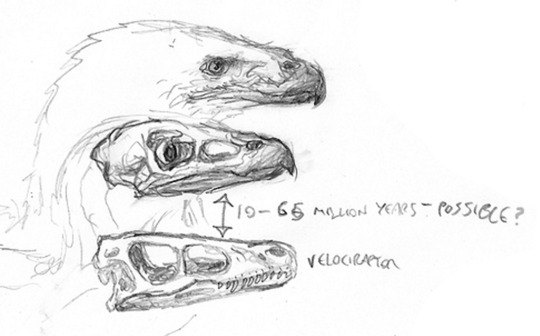
Many dinosaurs dabble in carnivory, but the main predatory niches on this version of Earth, are occupied by a diverse radiation of paradromaeosaurs, descendants of the famous “raptor” dinosaurs and kin. Paradromaeosaurs have diverged considerably from their ancestors. One lineage, known as the rhynchovenators, replaced their teeth with sharp, raptorial beaks.
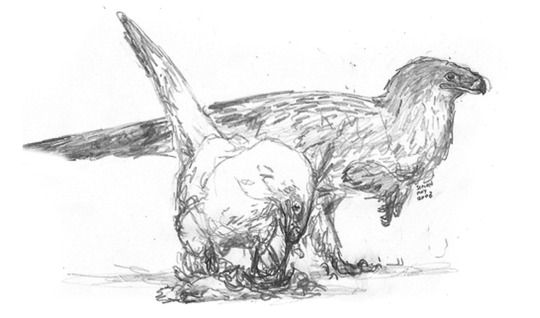
The male and female of the common boreal rhynchovenator, Rhynchovulpes agilis.

A lean-legged Egyptian rhynchovenator, Rhnychovulpes aegypticus, atop a dead multituberculate mammal. The key to rhnychovenators’ success is their added tenacity and stamina. Even a small rhynchovenator can overcome comparatively large prey by continually harassing and chasing it into exhaustion.
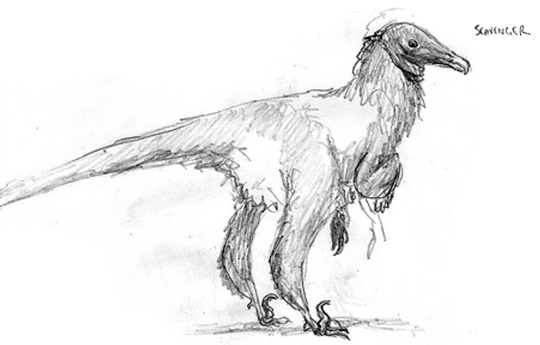
The bald-headed Osteophaganax regalis is a common scavenger encountered across the Caucaus Mountains. Its males develop striking, black-and-purple wattles on their faces during spring.
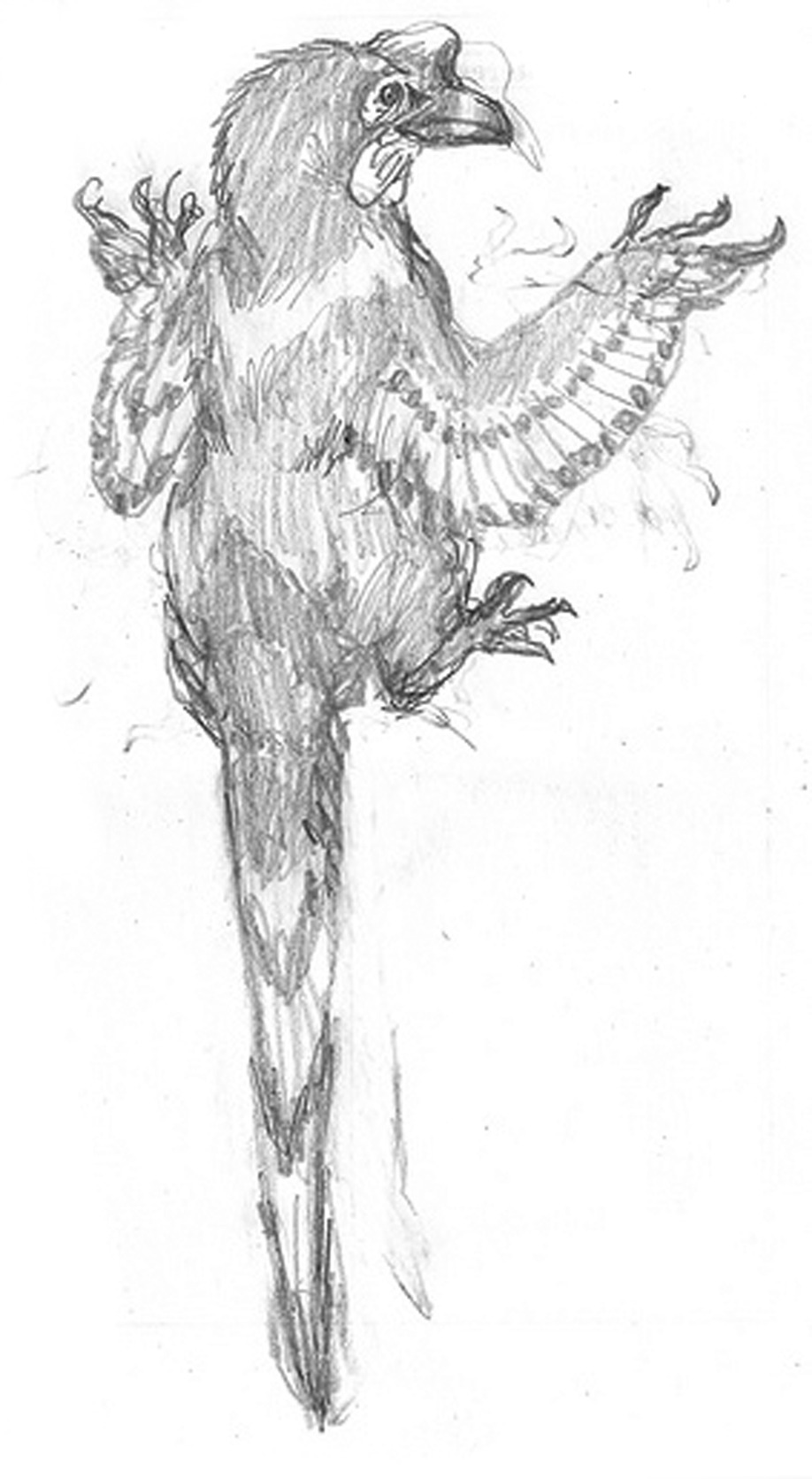

Two more derived troodonts. Left, a tree-dwelling arbosaur, Toucanops dixoni, from one of the diverse and little-understood clades found across the South American continent. Right, the lean, narrow-beaked Halophagus sp. from fossil deposits in what is now China. This group evolved specialisations for marine diving and probably saltwater drinking, before becoming extinct during the Miocene.
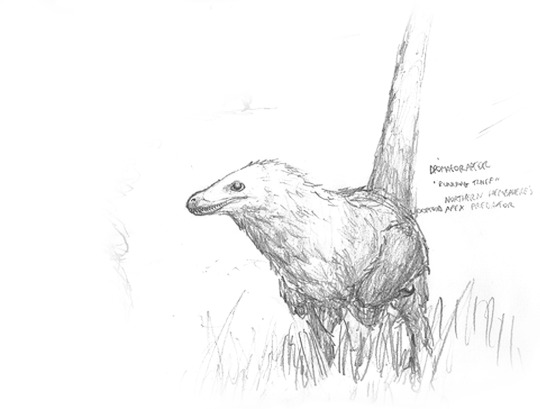
The dominant guild of maniraptoran predators, the tyrannoraptors, evolved from “regular” dromaeosaurs with powerful, biting jaws. Some species living today, such as the Savannahdromeus shown above, are still very similar to the earliest forms. Despite its small size, the smart and social Savannahdromeus are apex predators thanks to their pack-hunting behaviour.

Another basal tyrannoraptor, Pantherdromeus - is a solitary hunter that is common across much of Eurasia. It probably represents a diverse and subtly-variable species complex.

Solitary, basal tyrannoraptors eventually gave rise to the terrifying main-line tyrannoraptors in the last twenty-million years. The evolution of these animals was marked by the reduction of their wings and the enlargement of their legs, and jaws. Their tails developed into stiff and rod-like balancing organs. In some respects, they were the evolutionary echoes of the big-jawed, running tyrannosaurs, which had become extinct earlier on, during this world’s version of the Eocene period. Unlike tyrannosaurs, however, tyrannoraptors had well-developed social behaviours and intelligence; which, when coupled with their fast speed and terrific jaws, turned them into formidable apex predators. Above are the adolescent and mature forms of Metadromodaemon phobetor, a mid-sized hunter found in the Middle East and North Africa.
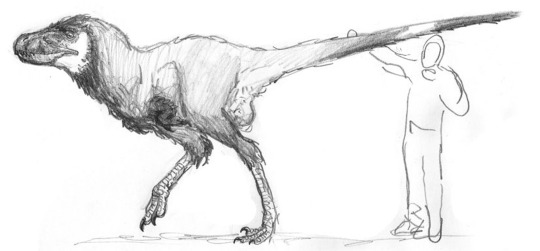
A scaled drawing of Wotandromeus bicolor, the terrifying, large-headed hunter of European forests.
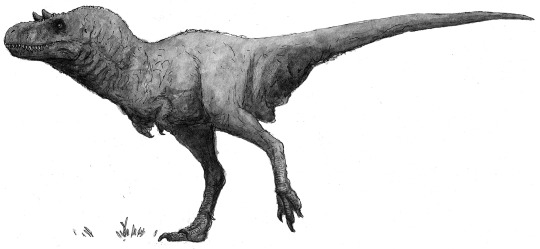
The seven-metre-long Melanorodromeus euceratus - also known by the Dinosauroids as “black thing” - is the largest predator on mainland Eurasia; but even larger forms are reputed to exist in Siberia and North America.

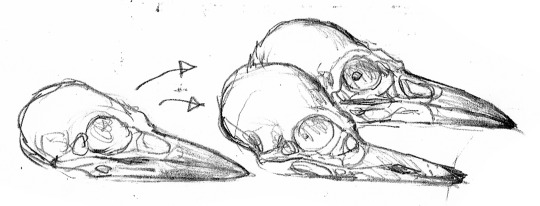
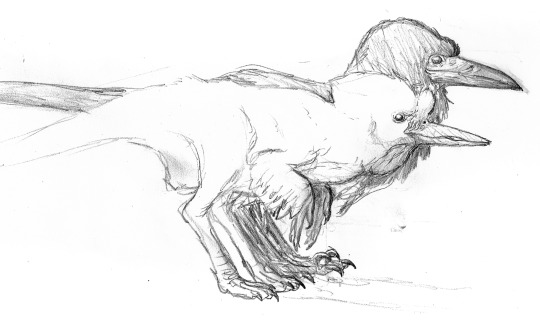
Let us now return to the Dinosauroids, their culture, and art. Above is a brief study illustrating the divergence of the two species of Avisapiens; A. saurotheos and A. tataricus, from ancestral eu-troodontid stock.


Especially A. tataricus shows considerable variation in beak shape, length and colouration. Above, right are the colouration of the Eurasian (top right, bluish-black), and Northeast Siberian (above right, yellowish-brown) races. Above, left shows a spectrum of variation in A. tataricus beaks. The cross-beaked and long, curved beaks occasionally crop up in certain bloodlines, which also have augmented song-memories. These individuals are revered as shamans in certain A. tataricus tribes; or are immediately killed-off as harbingers of doom in others.
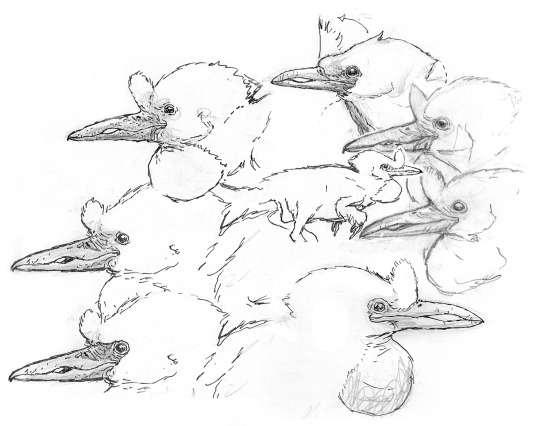
Above, the extensive variation in the head shapes, beak lengths and crests of various races in A. saurotheos. The bottom-right sketch depicts a hybrid individual between A. saurotheos and A. tataricus.
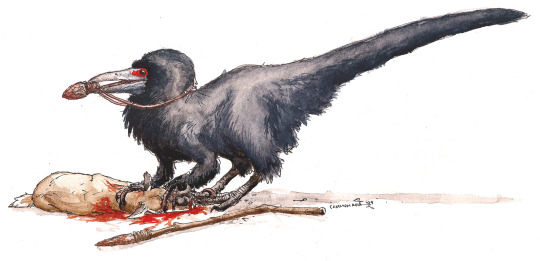
A powerful hunter of A. tataricus, from the Carpathian Mountains, showing a stone axe and bent spear that are characteristically used by this particular tribe.
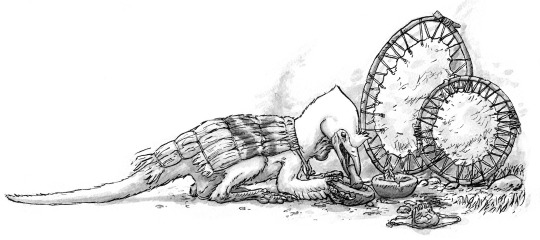
An artist/shaman of one of the settled A. saurotheos tribes living around the Balkans. He paints on animal skins stretched taut across circular frames, and paints using ground-up soil and other pigments, wielding a brush made from a wing-feather. The skin canvas also double as drums.
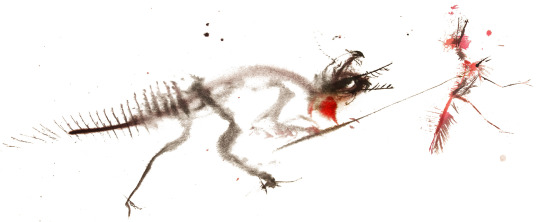
Art is one sure-fire way of identifying an intelligent species. This skin-painting shows a spear-hunter and prey, a painting by the aforementioned shaman.
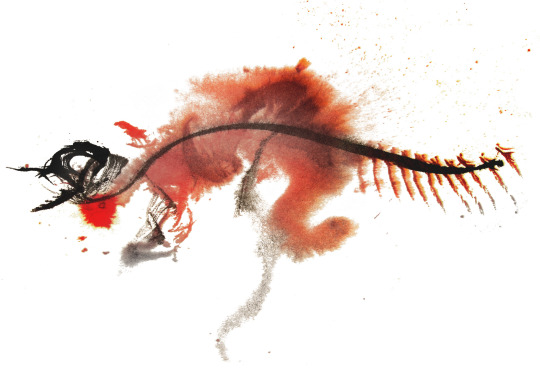
Painting of a god or hero-figure with red tail feathers.
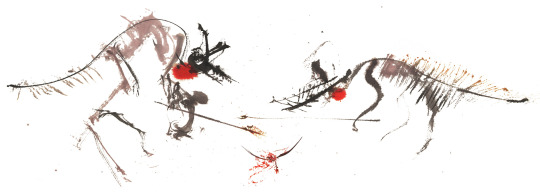
Painting of two shamans divining the future from the entrails of a dead flying animal.
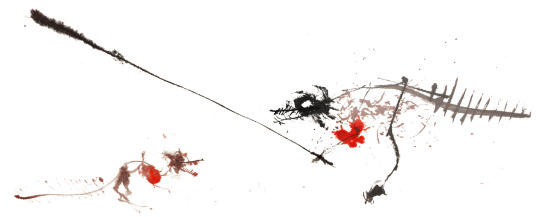
Painting of a hatchling being trained by a village elder.
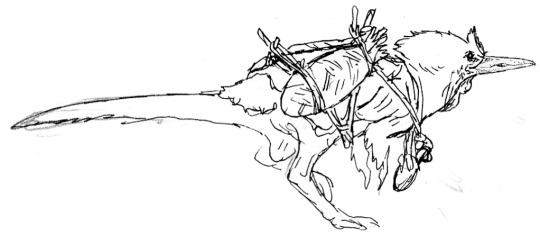

Studies of an A. saurotheos wanderer with a travel harness; and a duo of A. tataricus migrants with a domesticated bull-bird, a relative of the oviraptoriform Bosornithoides mentioned above.
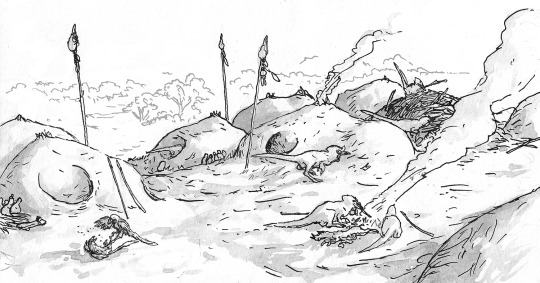
The view from an Avisapiens saurotheos village, showing the species’ characteristic nest-houses, and a pair of semidomesticated Cynornithoides jackal-birds playing in the village square. Note the heads mounted on tall poles, a sign of reverence to the spirits of the departed.
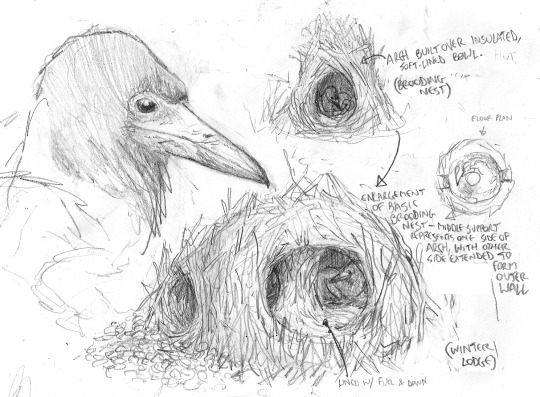
Detail of a brooding nest constructed by Avisapiens tataricus. Most tribes of these species are migrants that range across Eurasia, few build permanent structures.
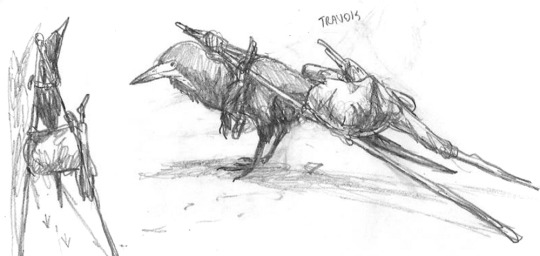
Sketch of an A. tataricus wearing a travois-like travel harness.
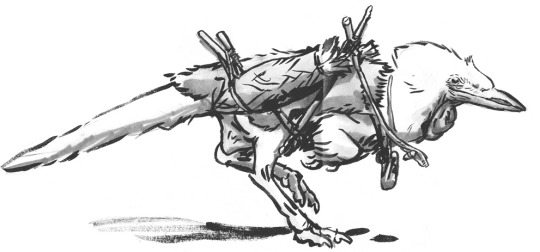
Study of an A. saurotheos wanderer with travel gear.
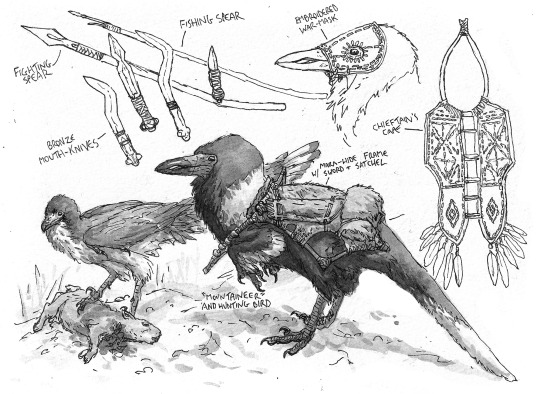
A detailed study of the burly A. tataricus native to the Caucaus Mountains, complete with weapons, travel gear and ornamental cape.
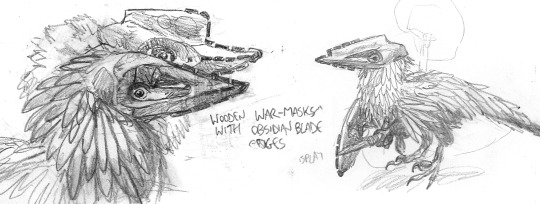
Sketches of war-like A. tataricus tribes native to the Eastern Mediterranean region. These tribes are known for their ferocious (if impractical) war-masks.
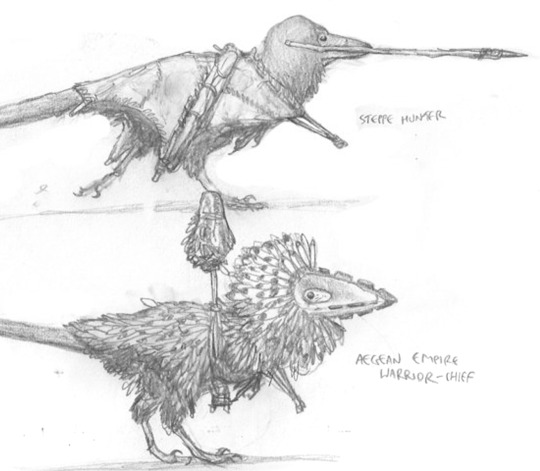
Studies of two different warriors from two different Avisapiens tataricus societies.
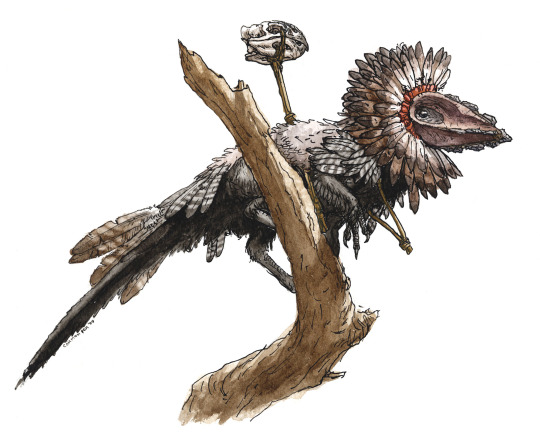
A resplendent A. tataricus warrior from the Levant, wearing an ornate head-dress of feathers, and an obsidian-studded war-mask.
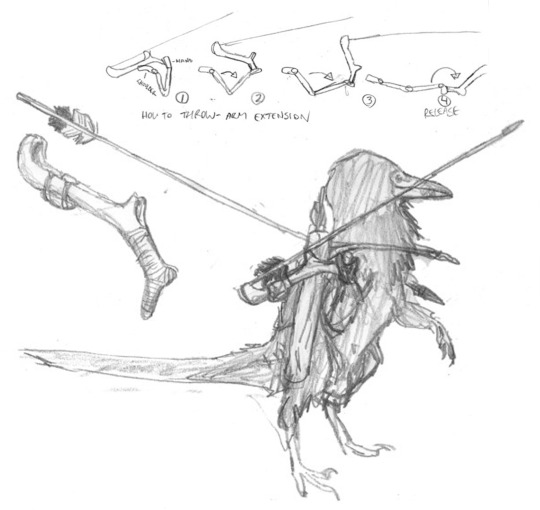
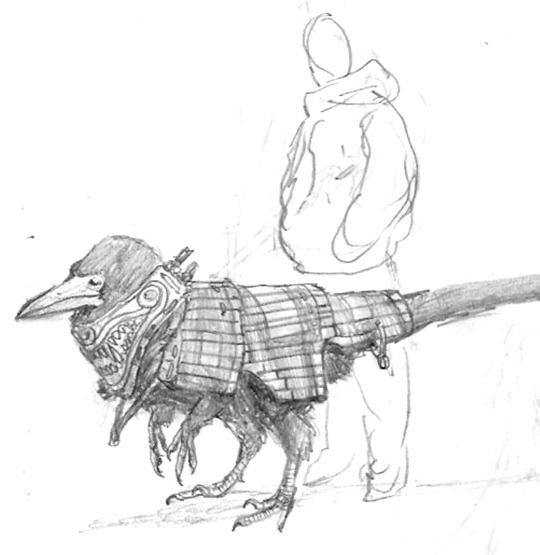
Studies for Avisapiens spear-throwers and wooden-slat armour; from a comparatively advanced period on this species’ societal development.
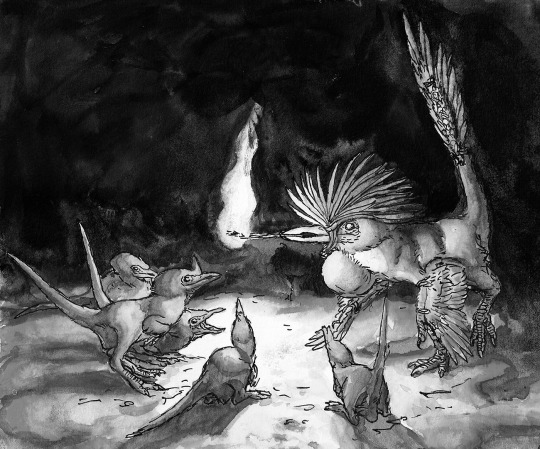
An A. saurotheos shaman entertains hatchlings with fireside tales of spirits and other worlds.

A band of slave-keeping A. tataricus warriors during a raid to an A. saurotheos village. A young shaman is captured and de-clawed.

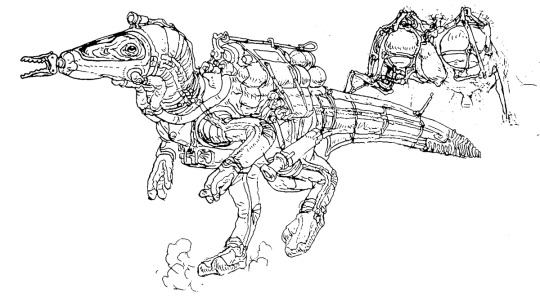
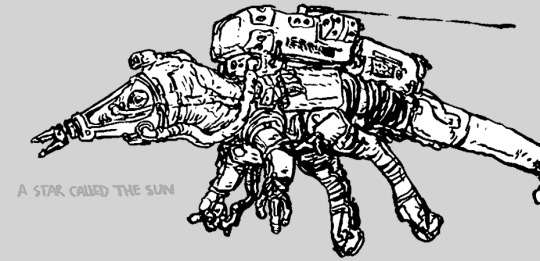
Simon Roy and I also dwelled on the far-future evolution of dinosauroid technology. The sketches above of a “knight”, moon lander and an astronaut were produced, but we did not pursue these scenarios seriously.

Let us conclude our visit to the dinosauroid tangent-universe with one last look at our artist/shaman, his village, and his paintings. Somewhere in deep time, they are still alive, and still waiting to tell us of their adventures.
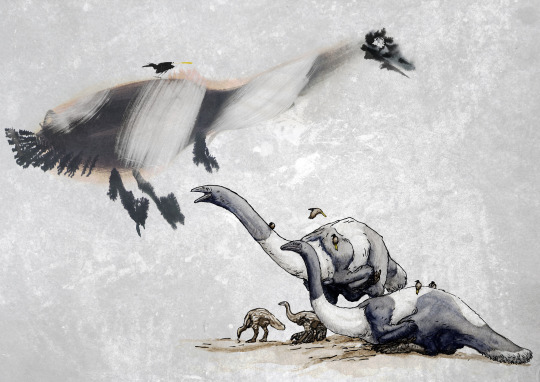
A painting of an avititan family.

A painting of the dangerous, predatory “black thing”.
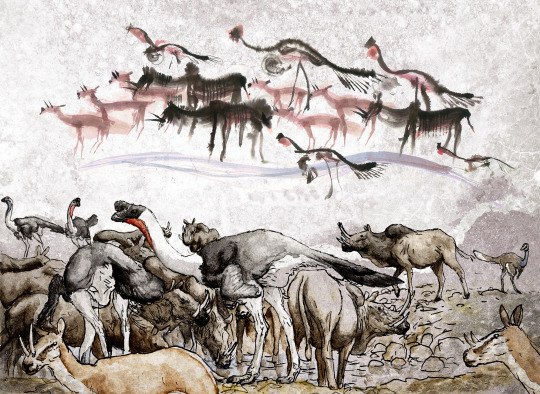
A painting showing numerous animals at a watering hole.
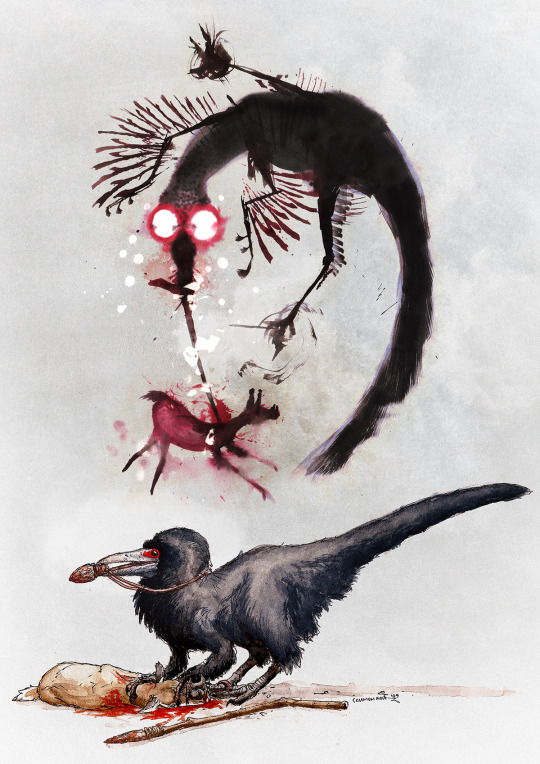
A painting showing an A. tataricus warrior.
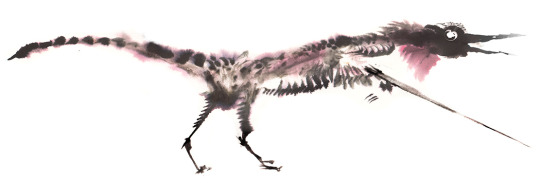

Stylised paintings of spear-wielding Carpathian warriors.
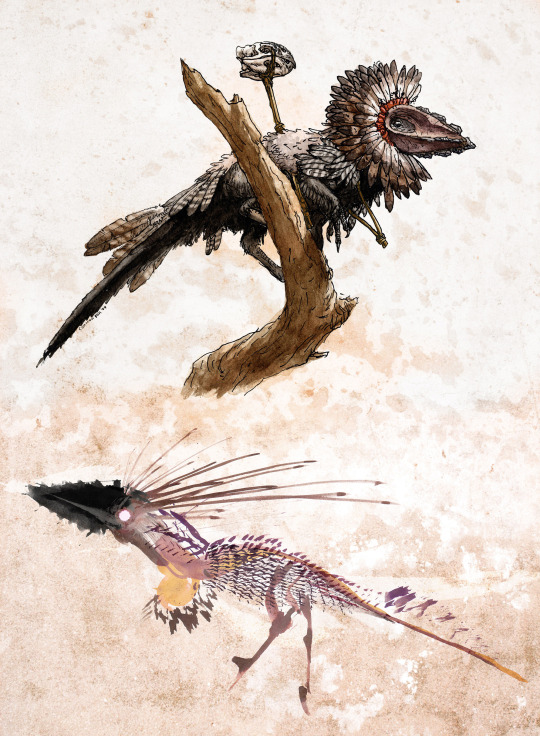
Painting of a ferocious Aegean headhunter.
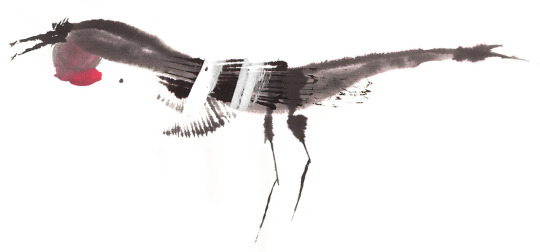
A stylised painting showing an immature dinosauroid.
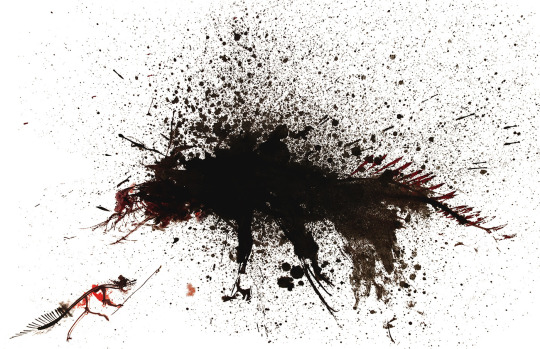
Stylised painting of a warrior confronting a spirit-creature.
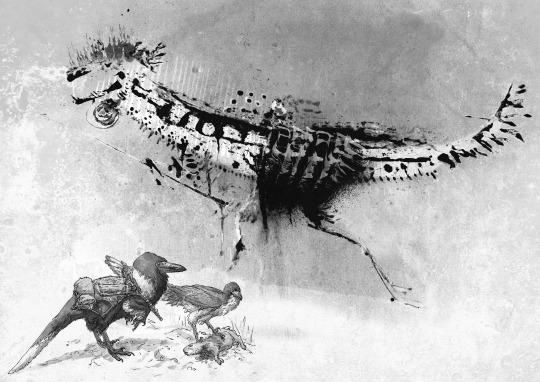
Stylised painting of a powerful Caucausian mountain warrior.
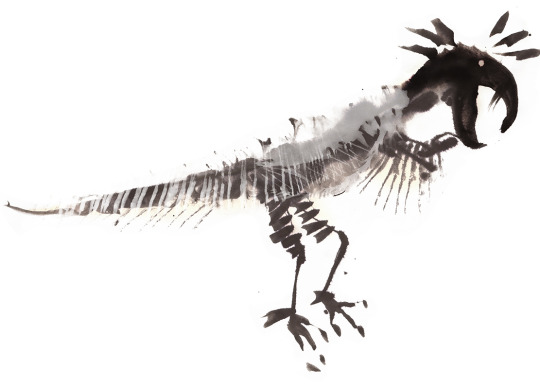
Painting showing a ghoul-like oviraptoriform animal.
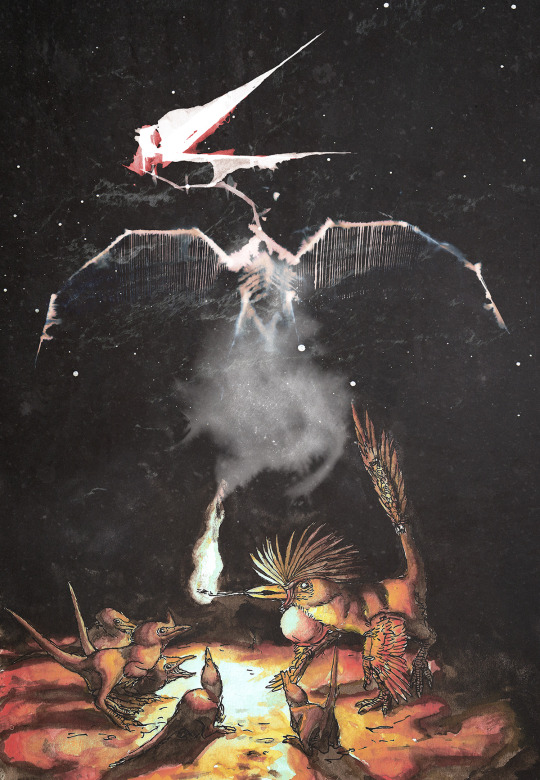
Painting of one of the sky-gods worshipped by A. saurotheos.
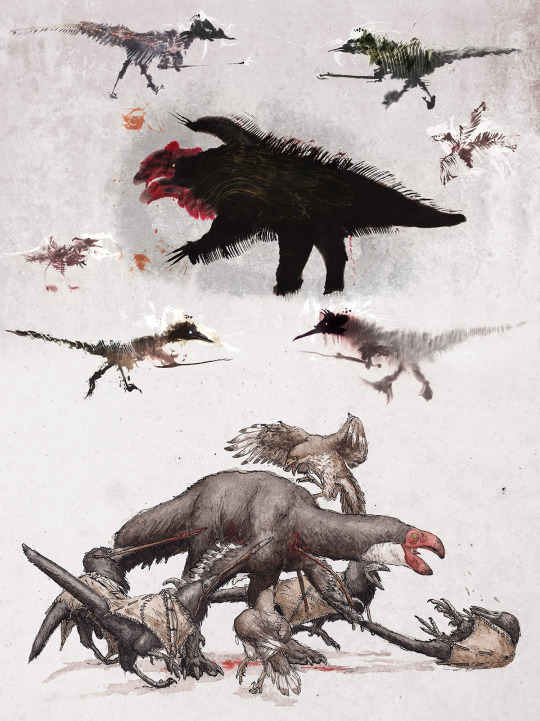
A complex painting showing four A. tataricus warriors hunting a bull Bosornithoides.
Simon Roy and I may return to the dinosauroids universe one day with a real story; but truth be told we enjoyed world-building far more than inventing stories and characters.
- 2008 - 10/2019.
#worldbuilding#speculative biology#speculative evolution#dinosaurs#dinosaur art#dinosauroids#paleoart#creature design#c m kosemen#simon roy
433 notes
·
View notes
Text
The First Anglo-Afghan War (1839-1842): Britain’s Great Game ends up meeting a dead end...
The region of Afghanistan has a long and varied history, one that is rugged like its topography of many mountain ranges, valleys and deserts. Its mix of barren wastes, snowy caps and forested patches of oasis. Its history has placed it at the crossroads of the geopolitical focus over the centuries. The focus of empires and of trade, often trying to assert its own path in history but so often a focal point of foreign ambition. As always to appreciate the modern we need to go back to earlier times.
Early History:
-Afghanistan is a patchwork of peoples, a testament to its status as a crossroads of empires over the ages. Primarily it sits in the eastern end of the ethnolinguistic region of Iranian peoples, a mix of ethno linguistically related but diverse groups of peoples from Persians (Farsi), Kurds, Ossetians, Baloch to Pashtun and Tajik among others. The latter two being the primary groups found in Afghanistan today, along with smaller Iranian groups like the Hazara & Baloch. Others include the Turkic Uzbek and Turkmens and a small number of Arabs.
-In ancient times Afghanistan was home to Iranian groups known as Bactrians & Sogdians who inhabited portions of the country. These peoples were incorporated into their fellow Iranians sphere of influence, the first Persian or Achaemenid Empire. This empire stretched from the Indus Valley in the East (modern Pakistan/India) to Greece and the Balkans in the West. Members of these groups served in the Persian Empire’s army but maintained their own traditions too. It is widely believed that the religion of the Persian Empire and of most Iranians in this time was Zoroastrianism, founded by Zoroaster in the region of Balkh in North Central Afghanistan. This religion would serve in some ways as an influence on the monotheistic Abrahamic religions of Judaism, Christianity & Islam later on history.
-During Alexander the Great’s march to conquer the Persian Empire, having defeated the Persians in three major battles and taken the western half of their empire, he sought to conquer the eastern half too which took him into the modern region of Afghanistan. The Macedonian armies under Alexander founded new cities here and brought forth Greek culture which began to merge with the local religion and culture. This Hellenistic culture spread as far as India as with Greek paganism, Hinduism, Buddhism and Zoroastrianism all mixing in the same cities as times. In the wake of Alexander’s death, his empire which essentially replaced the Persian Empire had no set structure of succession and quickly dissolved into portions going to his various generals. The largest expanse of which was the Seleucid Empire which spanned the whole of the Iranian plateau to India and to the Levant, this included Afghanistan. The region underwent many changes with portions being given to the Indian superpower of the day, the Mauryan Empire and later a successful uprising against the Seleucids, forming the Greco-Bactrian Kingdom which found itself at war with the Parthian Empire, a resurgent Iranian Empire which swept away the remnants of Seleucid Greek rule. These wars left Afghanistan open to nomadic invasions, namely from the nomadic branch of Iranians from the Eurasian steppe, coming in different waves. The Yuezhi and Scythians, the Scythians would later establish a kingdom that controlled portions of the region, the Indo-Scythian Kingdom as did the Yuezhi which became the Kushan Empire. Eventually this gave way to the second Persian Empire or Sassanid Empire which took over the region.
-All the while this region sat along the Silk Road spanning from the eastern reaches of the Roman Empire in the West to the Han Chinese in the East. Goods and peoples of different backgrounds travelled through the region, most just passing through but they all shared their influence, establishing Afghanistan as an important crossroads of commerce and not just conquest. Additionally, ancient sources attest to portions of Afghanistan, namely the region around the city of Herat being a major source of grain due to fertile farmlands in Central Asia as well as supplying vineyards of grapes for winemaking in the Persian world.
-In terms of religion, Afghanistan reflected the many changes of its many ruling peoples religions remaining a hub of Buddhism, Hinduism and Zoroastrianism along with lingering elements of Greek culture. This would change with the eventual downfall of the Sassanids in the 7th Century AD to the Islamic Caliphates and their gradual expansion over the Iranian plateau. Overtime Islam began to gradually take hold as the religion over the area but it was still set side by side with numerous other faiths and lived in relative tolerance to the other faiths. Eventually the Ghaznavid and Ghurid & Khwarazmian dynasties ruled over the area, a mix of Iranian and Turkic peoples who gradually made Islam the unifying religion of the region by the Middle Ages.
-The Mongols would invade and devastate the region in the 13th century. The devastation was so complete that the many settled cities were ruined, forcing the peoples of Afghanistan back into rural agrarian societies, something which has not been fully removed from the majority of Afghan society today. Overtime the peoples of Afghanistan, a region long noted for its literary, especially Islamic poetic contributions and had been a hotbed crossroads of cultural interfacing, was now reverted to an mostly tribal agrarian society once more. With some centers of learning gone forever Its peoples divided along ethnolinguistic grounds and into clans from there.
-There was somewhat a renaissance in the ages with the Turco-Mongol ruler, Timur and his empire ruled with new additions to architecture and culture contributed to the region but this was short lived. Meanwhile, a descendant of Timur named Babur would base himself in Afghanistan before launching an invasion of India and upon overtaking the Sultanate of Delhi, became the founder and ruler of the new Mughal Empire, the Islamic superpower that was to overrun much of India and dominate the subcontinent and beyond in the coming two centuries.
-Meanwhile, Afghanistan once more found itself on the fringe of an Iranian power, half the country at max was under the control of the Safavid Empire, a Kurdish dynasty that took power in Persia and expanded to reclaim historical “Persian” lands. Indeed the Persian (Farsi) language was regarded as the lingua franca of the region for centuries and was the language of the learned and most educated in the Islamic world as a whole, whereas Arabic was for mostly religious celebration. Persian was the language of government and the arts.
-Safavid rule was tenuous at best and their primary focus was facing the Turkish Ottomans to the west, leaving much of Afghanistan to de-facto local rule. Here the tribal societies that have dominated Afghanistan to the modern era, in part a result of the resumption of rural life after the Mongol destruction of the major cities held sway, with tribal leaders functioning as more or less warlords among the Pashtun and Tajik peoples and their various clans among others ruled over certain sections of the country. Only Islam united them in their differences. Much time was spent raiding and fighting each other, along with the few travelers who ventured into this increasingly isolated and remote portion of the world.
-The Hotak dynasty of Pashtuns had a hand in the downfall of the Safavids which was increasingly corrupted and weakened by intrigue at the royal court. In the wake of this, a Turco-Persianate ruler named Nader Shah took the reins in Persia and put down the Hotaks before setting up his own short lived Persian Empire, known as the Afsharid dynasty which pillaged the Mughals in India and defeated the Ottomans several times before Nader Shah was killed and his successors failed to maintain control. In Afghanistan, another Pashtun dynasty, the Durrani took power in the middle 18th century.
-The Durrani would for the first time in the modern age have a local Afghan power base that expanded beyond the borders of Afghanistan with any longer lasting impact. These mostly Pashtun peoples supported by some Persians invaded and controlled portions of India, defeating the Hindu superpower, the Maratha Empire at the peak of their powers at the Third Battle of Panipat in 1761. However the Durrani dynasty and its Emirate of Afghanistan, was weakened through ongoing external and internal pressures, military defeats from the Qajar dynasty in Persia and the new Sikh Empire in the Indian Punjab put closed in their borders. Eventually, internal conflict led to the fall of the Durrani dynasty with one its Emirs (leader), Shuja Shah going into exile in India hoping to return to rule. By 1823 the country had fractured into many smaller entities with civil war taking place until by 1837 Dost Mohammed Khan, founder of the Barakzai dynasty took power as Emir and reunited the country...
The Great Game:
-The exile of Shuja Shah and rise of the Barakzai dynasty in Afghanistan after much civil war by the end of the 1830′s was the state into which Afghanistan again entered wider geopolitics. Namely amidst the geopolitical struggle between the British and Russian Empires. Called the Great Game by the British as Tournament of Shadows by the Russians, this rivalry for geopolitical and economic influence was a likened to a game of chess whereby each power vied for influence, mostly through proxies, a precursor to the Cold War of the 20th Century between the US and USSR. Afghanistan it was hoped by both Empires would be one of those proxies.
-The British since the 16th and 17th centuries had pushed to become a naval power as well and felt that international commerce was the way to expand their economic and political power. Along with the Spanish, Portuguese, French and Dutch they all took an interest in naval power and setting up colonies in other parts of the world. In Asia, the Indian subcontinent became their primary focus. It was rich in resources such as tradable goods like cotton, silks, spices, jewels, salt, opium, various minerals and other commodities. It was also a vital link in the idea of a global empire in protecting commerce links on the way to Indonesia and China. Denying their main rival, France, influence in India was of high importance and by the mid 18th century, they became the unrivalled European power defeating the French at the Battle of Plassey during the Seven Years War. India was not united in any meaningful fashion at the time locally with various empires, kingdoms and principalities fighting locally over this vast area. They were divided by various ethnicities, religions and the usual drives of personal power and wealth. Due to this division, the Europeans who first established small trading factories gradually could expand their power to the interior of India and through mutual alliances of convenience between them and their local Indian trading partners they could compete with other Europeans. For some Indians, the European powers were initially more to their benefit, their presence was small but their weapons and military advantages were far superior giving them a strategic advantage over their opponents. In time, this power dynamic changed as the Indians had to continually grant the Europeans more power, namely the British who routinely defeated the Indians and began ceding more territory to them. Also the British’s vast wealth could now employ Indians against other Indian powers. Especially after France’s defeat at Plassey, no other Europeans seriously threatened the British interests. Britain’s East India Company, a joint-stock venture given great autonomy in the name of the British Crown had its own military, its own military officers school and total monopolies over half the world’s trade at one point.
-The British East India Company’ army had British officers, mostly Indian rank and file soldiers called sepoys and occasional regular British army regiments to complement it in its venture to conquer the whole of India by any means necessary. The East India Company also known as the Company had since the 17th century established a number of trading posts, most importantly Calcutta which was the capital of Bengal in the eastern portion of the country. This was decisively established after defeating the French and remnants of the crumbling Mughal Empire which they supported and which had declined since the 18th century due to the rising power of the Maratha Empire, India’s last great Hindu superpower before the British era.
-Britain focused their efforts of conquest on south India, first defeating after much initial difficulty the Kingdom of Mysore, run by Tipu Sultan. Later, battling the Maratha Empire which had piqued by the mid 18th century. Following their defeat by the Afghan Durrani Empire at the Third Battle of Panipat, the Maratha started a gradual decentralization that led to civil war, the Company got involved trying to place their preferred candidates in power in the Maratha hierarchy. The first war saw a British defeat but by the early 19th century, the British with Arthur Wellesley, the future Duke of Wellington, fought a second war, defeating the Marathas at Assaye from which they gained territory. They finished off the Marathas in 1818 and had by then essentially absorbed the whole of India with exception of the Punjab where the Sikh Empire had arisen under Maharaja Ranjit Singh at the end of the 18th century and grew in power in the first decades of the 19th century. The Sikhs had thrown off the last remnants of the Mughals in their realm and then pushed out the Afghans on their borders too.
-The Sikh Empire like many Indian powers used foreign mercenaries and officers from Europe & America to join their ranks, supply them with European and American style military training doctrine and supply them with the latest in military technology which far surpassed anything made in India at the time. The Sikh army was quite strong and had French officers providing most of the training, the Company’s default position was to make an alliance with them. The Sikh’s had troubles with Afghanistan, namely over the city of Peshawar and the Khyber Pass.
-The Russians for their part had expanded from Russia over the whole of Siberia towards the Pacific, this process had begun in the late 1500’s and was completed by the end of the 17th century. Leading to Russian exploration and colonization in Alaska and elsewhere in the Pacific during the 18th century.
-Russian expansion into Central Asia was in part a result of their off and on conflicts with the Ottomans and Persians in the past. By the second decade of the 19th century with the threat of Napoleonic France gone, their attention turned to maintaining a balance of power in Europe and a free rein in Central Asia. The threat to their influence as they saw it was Britain, which Russian tsars, namely Nicholas I, viewed with suspicion as far too “liberal” for their belief in absolute monarchy and conservative values. The British in turn were suspicious of Russian threats to their geopolitical spheres, namely gaining too much power at the expense of the Ottoman Empire or more directly to British India which was after the American Revolution to become the crown jewel in their global empire.
-The Russians gradually defeated the various Islamic emirates in Central Asia, taking over modern Kazakhstan, Uzbekistan, Kyrgyzstan, Tajikistan, Uzbekistan and Turkmenistan. The process was drawn out over several decades but through military conquest by the late 19th century would be achieved. It was as this Russian encroachment neared Afghanistan, that alarm amongst the British in India began to be raised…
The British Misinterpret Everything:
-Britain’s government and the East India Company misinterpreted the Russian view of events. It is true Russia sought to expand its influence but the British interpreted the expansion into Central Asia as meaning only one thing, eventual invasion and conquest of British India. Only Tsar Paul I in 1800 seriously pressed for an invasion of British India but he was assassinated and the plans for invasion never thought of as a practical reality by most in Russia’s military were cancelled. The Russians did want increased political influence in the area but even the most conservative of Russian tsars always believed a reproach with Britain could be obtained.
-The British also saw civil war in Afghanistan as well as the strength of the Sikh Empire as threats to their border and greater sphere of influence in India. The conflict between the Sikhs and Afghans meant they had to choose sides, they couldn’t be an alliance with both. Precisely, because of this conflict and the greater specter of Russian influence did Britain find itself on a course for war.
-In Afghanistan, the British and Russians had spies and intelligence agents acting as emissaries. The British had Scotsman Alexander Burnes, who joined the British East India Company. Burnes was stationed in Kabul and in turn his presence spurred the Russians to counter with their own envoy, the Polish-Lithuanian born Jan Prosper Witkiewicz. Both British and Russian envoys hoped to make an alliance with Afghanistan’s emir, Dost Mohammad Khan against the other. The emir for his part sought to regain Peshawar, recently lost to the Sikhs. This, however put the British in an awkward position, Company controlled India bordered the Sikh Empire and both sides had a mutual if tense respect for one another. The Sikh Empire was the last major independent kingdom of India outside of British rule and while Britain sought to eventually neutralize it, now was not the time. Furthermore, the Sikhs had a large standing army, with European doctrine, modern weapons and European officers who could pose a threat to British India, a threat they saw as greater than Afghanistan. Afghanistan had no formal army, only tribal men with tribal loyalties but nominally served their overlord the emir in times of national defense.
-Dost Mohammed Khan wasn’t enthused about the Russians to begin with but he believed the entertaining of an alliance might force the British to offer their alliance. Instead, given the British calculations of realizing they couldn’t support the Afghans over the more powerful Sikhs but also couldn’t abide the possibility of s Russian allied Afghanistan, moved closer to a casus belli for war.
-Burnes was apparently distraught at the arrival of the Russian envoy in 1836-1837, he wrote panicked reports. The Russians in turn reported on British maneuvers in Kabul. The British governor-general of India, Lord Auckland sent what amounted to a cease and desist letter to Dost Mohammed Khan. The letter was very demanding of Khan, ordering him to not negotiate with the Russians or even receive them as envoys. Khan was angered by this but wanted to avoid war. He had his own advisor, an American named Josiah Harlan talk to Burnes. Burnes argued he could only report on matters not make policy directly himself, Harlan saw this as merely stalling on his part and on his advice Khan expelled the British mission.
-Lord Auckland was now determined to force Afghanistan to submit to British demands. Furthemore, Russia and Afghanistan couldn’t come to a deal and their mission too broke down. Meanwhile, Afghanistan’s major western city, Herat was besieged by Qajar Persia with Russian material support. Fearful the Russians might use this as a pretext to invade Afghanistan proper, Auckland would in turn use it as a pretext to restore “order” in Afghanistan.
-Auckland reached a reproach with Ranjit Singh, the Sikh Maharaja. His goal was to fend off the Persians and their Russian support. He would also depose Dost Mohammed Khan as emir, seeing him as too unfriendly to British interests by his earlier negotiations with the Russians, as well his conflict with the Sikhs, who the British treated as a nominal ally at the time. His plan included placing the former Durrani emir, Shuja Shah on the throne once more. Shah had lived in exile in British india since 1818 and had been deposed in 1809. In the three decades since he last reigned, he was hardly remembered by anyone, aside from those who remembered his cruelty that had led to his deposition in the first place. Shah had been given a Company pension and comfortable living in exile, considered a useful pawn in British geopolitics, he in turn was willing to ally with anyone who would support his restoration to the throne. Auckland was led to believe that Shah was actually popular and that the instability in Afghanistan meant Khan was unpopular himself, the inverse turned out to be the case...
The First-Anglo-Afghan War:
-By October 1838, Auckland sent the so called Simla Declaration which resolved the British and the Sikhs to march in Afghanistan and restore Shuja Shah to the throne on the grounds that Dost Mohammed Khan was unpopular, had lead to instability within the country, was a threat to the Sikhs and British by extension and given rise to the prospect of foreign (Russian) interference.
-In Punjab, Lord Auckland and Ranjit Singh held a grand parade of the so-called Grand Army of the Indus which would march in Afghanistan jointly to bring “order”. Two things happened in the interim. The Persian siege of Herat was called off and the Russian tsar had recalled his envoy altogether. The British pretexts for war ended before war began. Auckland and others heading the Company’s policy in India however were deadset to commit to a military operation, believing Afghanistan essentially needed to be put in its place, meaning it needed a British backed ruler who would amount to a puppet and could put British interests in the region first.
-December 1838 saw the British East India Company’s 21,000 strong army set out for Afghanistan. Composed of British and Indian troops (mostly rank and file Indians and British officers) along with nearly 40,000 Indian camp followers, Indian servants, families and even prostitutes following too. Ranjit Singh in the end backed out of the plan, not sending any troops to aid in Afghanistan.
-The British trek took months to cross the snowy Hindu Kush mountains. Finally they reached the area near Kandahar in April 1839. From there they waited two months until better conditions in the summer to march to Kabul. The British found themselves having to besiege the fortress-city of Ghazni in July. Eventually upon destroying a weakened gate, they breached the city and after much fighting captured the city.
-Khan upon hearing of Ghazni’s fall, offered a surrender to the British, he was replied with removal of his position on the throne to a life of exile in India, this was unacceptable, so the march to Kabul continued, though Ghazni remained occupied.
-A battle took place outside of Kabul which forced Dost Mohammed Khan to flee the city, the British entered and Shuja Shah was placed on the throne. The war was seemingly at end, the main objective achieved, Khan’s removal and Shah placed on the throne. Most of the British Indian force returned to India, leaving some 8,000 to occupy Afghanistan in various places from Kandahar to Kabul.
-The initial invasion was successful but the occupation and continued support of Shuja Shah was costly in terms of public relations for the British. Shah resumed his cruelty, he punished and executed those who he considered traitors from decades before. By his own admission, his people were dogs in need of “obedience” and corrective punishment. He raised taxes which hurt the already impoverished economy. This hurt his limited popularity along with his essentially martial rule, upheld by the British. Now, a guerilla war phase was being instituted by various Afghan groups, some loyal to Khan and some just offended by the presence of foreign invaders.
-The British for their part did not help matters. Many officers imported their families from India into Kabul, where they took residence in a cooler mountain valley climate, they created gardens and set up English country gentrified life in the Afghan capital. Some English customs weren’t especially troublesome to the Afghans, tea drinking socials, cricket and polo, even ice skating on frozen ponds in the winter which actually amazed the Afghans having never before seen such a thing.
-However, the more the British lingered, the sense they'd never leave crept in, their presence in the daily markets brought raised prices which coupled with higher taxes meant they were linked with such economic hardship. The British also drank alcohol and had wine cellars fully stocked, in a devout Muslim country this was offensive given Islamic prohibitions on alcohol. However, most trying for the Afghan populace was the sexual relations between the occupiers and Afghan women. British men soon found themselves acquiring the services of willing Afghan women for prostitution. Afghanistan was quite poor to begin with and coupled with hardships brought on by the invasion a number of Afghan women, married or unmarried found themselves becoming prostitutes to the British. Afghan women realized even the lowest paid British soldier was more wealthy than Afghan men, so their turns to prostitution were not unsurprising. Others willingly entered into romantic relationships with the British and indeed some British officers did marry Afghan women, including daughters of tribal leaders. This development offended the Afghan men, particularly the Pashtun who had a sense of society that revolved around honor to manhood, any slight real or imagined could be responded to with justified violence in their code of honor. The Pashtun men could enact honor killings on women who fraternized with the British, on the grounds that these women brought shame to the men in their family for engaging in immoral behavior and for sleeping with infidel Christians.
-The guerilla war that developed in reaction to the British also spurred their sense of prolonging their stay. Shuja Shah knew more British was the only way to ensure his continued reign. Isolated British outposts or patrols could be attacked in ambush due to fighters whose entire fighting style relied less on technical skill or discipline beyond waging ambushes and raids. Most Afghan warriors would have been armed with little more than an old matchlock musket or possibly a dagger or sword.
-The British nevertheless were negotiating with Shuja Shah to develop a standing army and do away with the tribal levy system. He argued there was not enough infrastructure or more succinctly, funding to maintain a standing army. So the British occupation dragged on.
-Dost Mohammed Khan was eventually taken prisoner and exiled to India. However, his sons continued to wage the war on their dynasty’s behalf.
- By 1841, George Elphinstone was in charge of the British forces in Kabul, most of his time was spent bed ridden with gout and other ailments.
-Early November, saw in motion a planned uprising. For months through Shuja, tribal chieftains had their loyalty earned by bribes of money. The British used this as a way to pacify the resistance with some success but it was a tenuous development. The spark for the uprising in Kabul came from British agent, Alexander Burnes. Burnes had been particularly well known for his sexual relations and womanizing of Afghan women and was viewed as largely a focal point of the resentment Afghans had towards the British. The final straw came when a slave girl from Kashmir who belonged to a Pashtun chieftain escaped to Burnes home. At first the chieftain sent retainers to retrieve the girl, only to find Burnes in the act of sleeping with her himself, Burnes own guards then beat the retainers and sent them on their way. The chieftain, having his code of honor offended along with other chieftains, proclaimed jihad. The next morning a large riot broke out at Burnes residence in Old Kabul, away from the British camp which had moved to the outside of town. Burnes, his brother and others were hacked to death by the angry mob, their beheaded skulls placed on pikes for display. Shuja Shah sent a single British regiment to put down the events, it suffered casualties and was forced to return. Shuja realized the people were rebelling against him and the British and he was effectively overthrown.
-Elphinstone was gripped with indecision on how to deal with the matter, he wrote to the Company Civil Administrator, William Macnaughten. Macnaughten tried to negotiate with Akbar Khan, son of Dost Mohammed, with an eye towards making him vizier, in exchange for extending the British stay. Macnaughten also negotiated with other tribal leaders to assassinate Akbar Khan. The news of these two faced dealings led to Macnaughten being captured and killed by Khan’s men, his body dragged through the streets of Kabul.
-Elphinstone realized it was time to withdraw, the British presence no longer tenable. The Afghans had not attacked the encampment directly due to the concentrated British strength but these appeared to be only a matter of time. He made the decision to withdraw the garrison, 4,500 strong with 12,000 camp followers including family and mostly Indian servants and some Afghan women who preferred life with their British lovers as opposed to facing the wrath of their angered families who would kill them for shaming them.
-January 1842 saw Elphinstone’s withdrawal in a massive column through snowy passes. The retreat dragged out for weeks with little food, bad weather and repeated attacks from Pashtun guerillas who attacked and killed as many as they could. Repeatedly, Elphinstone met with Akbar Khan to call off the attacks, Khan allowed the English women and children to return to Kabul to be ransomed later, but the Indian camp followers were not spared, they were forced to freeze to death in the snowy passes. Meanwhile as Elphinstone and the army marched on, the attacks continued with Khan playing Elphinstone for a fool. Eventually, he treated Elphinstone to a good meal before taking him prisoner, Elphinstone would die as a hostage some months later. The 44th Foot, the only all British regiment made a famous last stand fending off many Afghan charges before being overrun. The British column was mostly starved, frozen or hacked to death in the passes, most of the victims being Indian sepoys or their families and camp followers (servants) of the British officers. Some British women and children remained in Afghan captivity for a time, with some being ransomed and released, most being well treated. Some women were forced to marry their captors and others as children were adopted into Afghan families, some living into the early 20th century in Afghanistan. Only one British doctor and some scattered sepoys survived the ordeal at all. Much of this episode was detailed by Lady Florentia Sale in a diary, later published to great acclaim. She would spend nine months in captivity before her and her daughter were rescued by the British.
-The Afghans stormed the other British garrisons but all these attacks were repelled, in turn British reinforcements were arriving from India. These reinforcements subsequently beat Akbar Khan in a pitched battle. Plans were underway for a retaking of Kabul with a new larger force but Lord Auckland suffered a stroke and was replaced by Lord Ellenborough as Governor-General of India. Plus, elections in Britain’s parliament brought a new government with orders to change policy, withdraw from Afghanistan, which found itself in a military stalemate. A last battle took place in which Akbar Khan who was routinely defeated in pitched battles was beaten again with huge casualties at Kabul. However, the measure was merely punitive for the deaths of Elphinstone’s column. The Company at government orders withdrew all British troops from Afghanistan, having inflicted numerous deaths on the Afghan side and destroyed more forts of theirs but politically been unable to change the situation.
-Dost Mohammaed Khan was allowed to return where he co-ruled with his son Akbar who eventually died in 1845, possibly poisoned on orders from his father, who is rumored to have misgivings about his ambition. Dost Mohhamed Khan’s primary goal was to restore Peshawar from the Sikhs all along, during the Anglo-Sikh Wars that followed in the decade ((1845-1846 & 1848-1849), he was nominally neutral albeit he somewhat supported his old rivals the Sikhs with an Afghan mercenary force, still hoping to negotiate Peshawar. These wars resulted in British victory over the Sikhs, the last of Indian independent kingdoms fell and India was more or less completely in Company hands, the Afghan border nor directly bordered British India in the Punjab. The British never returned Peshawar despite their own promises to do so, but Dost having faced his own temporary overthrow and captivity realized, the British were far too powerful to resist in the long run and so he maintained quiet on his part, staying neutral during the Indian Mutiny of 1857, ruling until his death in 1863.
-The British for their part were defeated in the first Anglo-Afghan War, though their military generally held the upper hand in pitched battles and their initial invasion for all its hubris and motivations was successful. It was the occupation that proved too much of an expense than originally endeavored. British arrogance and ignorance of local custom also worsened reception of their plans. In the end, it was British paranoia, belief in imperial prestige and jingoism that had led to a war that while a limited military success was a political failure, having achieved none of their goals, which seemed to shift as the situation shifted. It was a confused war, brought on by people on all sides misreading the events surrounding them and made worse by their stubborn commitment to short-sighted policy goals and ego. Britain would avoid venturing into Afghanistan for nearly forty years when similar disputes over diplomacy led to a second war...
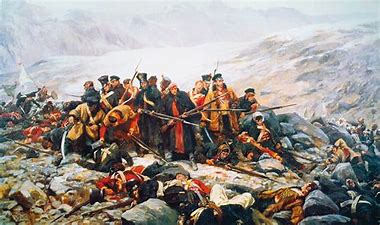

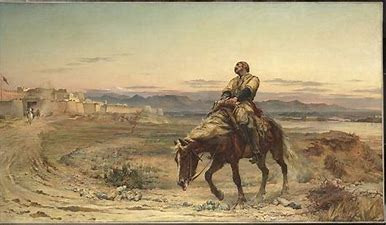
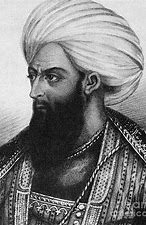
#19th century#military history#afghanistan#the great game#british imperialism#british east india company#india#islam#pashtun#tajik#persian#russian empire#guerilla warfare#kabul
7 notes
·
View notes
Text
‘Climate windows’ allowed the first human migrations
New modelling reveals when conditions were favourable for ancient humans to leave Africa.
Migration is part of the great evolutionary story of our species – humans first evolved in Africa several million years ago, before leaving those homelands and spreading across the world in a series of epic journeys.
But there has long been debate about exactly when humans left Africa and the routes that were taken. This is partly because the evidence, including fossils and artefacts found outside Africa, is scarce.
“We have to work with very fragmentary bits of information,” says Andrea Manica, a professor of evolutionary ecology at the University of Cambridge.
“We often lack archaeological sites in the interesting places – the coastlines that might have acted as corridors are now underwater, and, in general, the areas that might have been important don’t have very favourable climates to preserve ancient remains.”
Read more: Oldest human burial in Africa unearthed
Manica has co-authored a new study in Nature Communications that uses a different approach to narrow down early human migration. It models the climate over the past 300,000 years to pinpoint when conditions might have made it easier for humans to move.
“To move out of Africa, you need to cross large areas that, at times, are very inhospitable,” he explains. “The main barrier for the exit are very dry regions in North Africa and the Arabian Peninsula, so we looked specifically at variation in precipitation.”
By combining past climatic conditions with the distributions of contemporary hunter-gatherers, the team determined that humans can survive in areas that receive more than 90 millimetres of rain per year. This provided a threshold, above which were lusher, wetter conditions that the researchers suggested created ‘corridors’ along which humans could travel out of Africa.
So, when did those conditions occur?
“We found that there were a number of time windows that were suitable (for) human migration out of Africa well before the major exit that happened approximately 60,000 to 50,000 years ago – from which all contemporary humans descend, based on genetics,” explains Manica.
They looked at the conditions along two potential routes from Africa into Eurasia: one along the Nile (northern route), and the other along the narrow Bab-el-Mandeb Strait (southern route).
They found several windows where a wet corridor opened up along the northern route, including between 246,000 and 200,000 years ago, a number of times between 130,000 and 90,000 years ago, and around 78,000 to 67,000 years ago.
“After that, this route likely remained closed until the wet Holocene,” the team writes in the paper.
Whether humans seized these opportunities remains to be seen.
Read more: Meet the new relative: ‘Dragon Man’
On the other hand, the team says, “provided that maritime travel was in principle possible, climatic conditions would have made southern exits feasible for a substantial proportion of the last 300,000 years.”
The largest climate window occurred between 65,000 and 30,000 years ago along this southern route, which coincides with previous genetic and archaeological research showing that this was the most successful human migration out of Africa.
“Our work provides a catalogue of favourable periods when exits might have happened, which helps assessing how plausible some of the other lines of evidence for earlier exits are,” says Manica.
Michelle Langley, an archaeologist from the Australian Research Centre for Human Evolution at Griffith University, comments that “new analyses which narrow down the possibilities are very useful for working out where we should focus our investigations”.
“The several early dates (windows of opportunity) that the authors suggest are interesting to consider in light of what we know and emerging evidence from a number of different sites,” adds Langley, who was not involved in the research.
The big question now, he says, is why the exit around 65,000 years ago was so successful, leading to the full colonisation of the Eurasian continent and then the world.
“Something must have happened, because there were plenty of previous opportunities,” Manica says. “Changes in competition with other hominins (Neanderthals and Denisovans were on their way out at that time) might have been the key, but we really don’t know at the moment.”
‘Climate windows’ allowed the first human migrations published first on https://triviaqaweb.weebly.com/
0 notes
Text
Cap 164 : Yacimiento de Monte Verde en Chile enloqueció a los de Hipótesis Clovis
.
Aquí ves a Buenos Aires a la derecha y Santiago de Chile a la Izquierda. Monte Verde abajo cerca al Océano Pacífico. .

.
******************************
.

.

.
******************************
.
De la Revista Science :
.
Genetic studies of contemporary Indigenous people and ancient individuals from Asia and the Americas reveal an outline of the ancestry of the first humans to settle the Americas, providing age estimates for the timing of population contact, divergence, and migration. Studies of contemporary mitochondrial DNA (mtDNA) and Y-chromosome DNA lineages gave the first genetic insights into Indigenous American population history (6). These studies demonstrated that the ancestors of all contemporary Indigenous people had descended from only five maternal lineages (haplogroups A, B, C, D, and X) and two paternal lineages (haplogroups C and Q).
These lineages also showed that the founding population came from Asia and experienced a severe genetic bottleneck, in which a small number of people with limited genetic diversity gave rise to all Indigenous people who occupied the continent before European arrival. Further, mtDNA analyses suggested that the source population from which the first Americans were derived had been isolated from Asian lineages, most likely in eastern Beringia, before they dispersed south. After this “Beringian Standstill” (6), a small group fissioned from this isolated source population, traveled south of the continental ice sheets that covered most of Canada, and explored and successfully populated North, Central, and South America.
Analysis of the genomes of contemporary Indigenous populations and ancient human remains has built on this framework to provide a deeper understanding of the first American ancestry (6–13). These genomes show that the ancestral Indigenous American population emerged in Eurasia, descending from a single founding group that split from ancestral East Asians ∼36 ka ago, but maintained a high level of gene flow with East Asians until at least ∼25 ka ago. This ancestral population also received gene flow from ancient Siberian populations with northern Eurasian ancestry (Mal’ta) until ~25 to ~20 ka ago. Afterward, the ancestral Indigenous American population became isolated from external gene flow.
............................
Along the Pacific coast of South America, at Monte Verde II in southern Chile, structural foundations, hearths, wooden tools, lithic artifacts including bipointed El Jobo projectile points, bolo stones, medical and edible plants, and animal bones and hides were found on a discrete buried surface (69). Radiocarbon ages from hearths within two of the structures date to 14.2 ± 0.1 ka ago. At the Huaca Prieta site in Peru, 42 artifacts including debitage and edge-retouched flakes and cobbles were buried within multiple discrete layers of alluvium dated from 14.15 ± 0.05 to 13.35 ± 0.05 ka ago.
The evidence from most of these sites has been criticized. However, the questions raised about each site have been addressed with new data to provide secure evidence that people were in the Americas by ~15 ka ago.
..
Late Pleistocene exploration and settlement of the Americas by modern humans Science 12 Jul 2019: Vol. 365, Issue 6449, eaat5447 DOI: 10.1126/science.aat5447
.
https://science.sciencemag.org/content/365/6449/eaat5447?rss=1&utm_source=feedburner&utm_medium=feed&utm_campaign=Feed%253A%20sciencemag%252FBIoA%20%2528ExcitingAds%2521%20Science%253A%20Current%20Issue%2529
.
******************************
.

.
Esta Imagen viene de aquí : Monte Verde: Un día en uno de los sitios arqueológicos más antiguos de América Museo Nacional de Historia Natural de Chile
https://www.mnhn.gob.cl/noticias/monte-verde-un-dia-en-uno-de-los-sitios-arqueologicos-mas-antiguos-de-america?_noredirect=1
.
******************************
.
Una interpretación pictórica del artista Rodrigo Díaz sobre cómo pudo ser la cultura Monte Verde.
.

.
Esta Imagen viene de aquí :
Monte Verde, en Chile: ¿primer asentamiento humano en América o teoría "antiyanki"? Natalia Messer Chile, especial para BBC Mundo 18 octubre 2016
.
https://www.bbc.com/mundo/noticias-america-latina-37507422
.
******************************
.
Rafael Suárez de Uruguay tiene Libro con muchas Puntas Líticas del Cono Sur. Estas son de Monte Verde II - Cortesía de Thomas Dillehay.
.

.
Pre-Fishtail settlement in the Southern Cone ca. 15,000-13,100 yr cal. BP: synthesis, evaluation, and discussion of the evidence - January 2014
In book: Pre Clovis in Americas: International Science Conference Proceedings (pp.153-191) Editors: Dennis Stanford and Alison Stanger Author : Rafael Suárez Uruguay
.
https://www.researchgate.net/publication/271442358_Pre-Fishtail_settlement_in_the_Southern_Cone_ca_15000-13100_yr_cal_BP_synthesis_evaluation_and_discussion_of_the_evidence
.
******************************
.
Siguiente Imagen : Ves la Ciudad de los Angeles, California arriba, San Diego y Tijuana abajo a la Derecha. Arriba a la Izquierda están las Islas del Canal, Parque Nacional. La de la Izquierda es Santa Rosa. Esta Islas son importantísimos Yacimientos Arqueológicos que parecen apoyar la Hipótesis de la Ruta Costera para los Paleoindios penetrar en el Nuevo Mundo, usando Botes con los que pescaban y capturaban Mamíferos marinos.
.

.
Many archaeologists now believe that the initial peopling of the Americas followed a coastal route around the Pacific Rim from Northeast Asia into the Americas. A growing body of archaeological, geological, and genetic data support the feasibility of such a coastal dispersal, as does extensive evidence for seafaring by anatomically modern humans (AMH) from islands of East Asia and greater Australia between ~55,000 and 30,000 years ago. With global sea level rising ~100–120 m in the last 20,000 years, identifying Late Pleistocene archaeological sites in coastal settings is difficult, but recent research demonstrates that several parts of North America’s Pacific Coast were occupied by humans between ~14,000 and 13,000 years ago.
Monte Verde II in Chile, a peri-coastal site occupied ~14,500 to 14,000 years ago, has produced several types of edible seaweed and supports a coastal dispersal [4]. So far, however, the earliest Pacific Coast sites have produced only tentative evidence for technological connections to coastal Northeast Asia, although some have proposed a potential connection between terminal Pleistocene Pacific Rim assemblages containing stemmed (or tanged) points, crescents (lunates), and leaf-shaped (foliate) bifaces.
In the last two decades, coastal southern California has produced a variety of archaeological data supporting a Late Pleistocene human occupation in the New World, including evidence for early maritime economies and seafaring. The Arlington Springs site (CA-SRI-173) produced three human bones from a single individual dated to nearly 13,000 cal BP [7], but no diagnostic technology. Erlandson et al. [8] identified a maritime Paleoindian tradition on California’s Northern Channel Islands (NCI) that contains stemmed points, crescents, and leaf-shaped bifaces dating as early as 12,200 cal BP, artifacts that appear to be linked to the Western Stemmed Tradition (WST) of western North America.
More than 100 Paleocoastal sites (~13,000–8,000 cal BP) have been documented on the NCI, but only a few sites older than 11,000 cal BP have produced sizable, well-dated artifact and faunal assemblages [9]. One of these, CA-SRI-512, a buried site near the mouth of Arlington Canyon dated to ~11,700 cal BP, is estimated to have been located as much as 5–6 km from the ancient coast, and has produced scores of bifaces (CIBs, crescents, and foliates) and thousands of bird bones. CA-SRI-512 remains something of an anomaly among early island Paleocoastal sites, however, leading some to question the commitment to seafaring and maritime subsistence among early islanders.
.
Maritime Paleoindian technology, subsistence, and ecology at an ~11,700 year old Paleocoastal site on California’s Northern Channel Islands, USA
.
https://journals.plos.org/plosone/article?id=10.1371/journal.pone.0238866
.
******************************
.
1 note
·
View note
Text
Jaisalmer Tourism | Jaisalmer Attractions
Jaisalmer Tourism
Jaisalmer is where you need to journey. The city of Jaisalmer also acts as the guard to western Rajasthan (and India’s) frontier. This 'Golden City’ is located close to the Pakistan border and in close proximity to the Thar Desert. The city’s most prominent landmark is the Jaisalmer Fort, also called Sonar Qila (Golden Fort). Unlike most other forts in India, Jaisalmer Fort is not just a tourist attraction. It houses shops, hotels and ancient havelis (homes) where generations continue to live.

Jaisalmer traces its inception to the 12th century. History tells us of Rawal Jaisal, the eldest heir of the Rawal of Deoraj, was passed over for the throne of Lodurva and a younger half-brother was crowned king. Rawal Jaisal went looking for a new location to set up his capital when he came across sage Eesul. The sage told him about Krishna’s prophecy which said that a descendant of his Yaduvanshi clan would found a new kingdom at this same spot. It was in 1156 that Rawal Jaisal constructed a mud fort, named it Jaisalmer after himself and declared it his capital.
Famous 19 Places To Visit In Jaisalmer :-
AMAR SAGAR LAKE :-
Amar Sagar Lake, located about 7 km towards the western outskirts of Jaisalmer, is a lake cum oasis lying adjacent to the Amar Singh Palace. The palace itself was built in the 17 th century. The complex that includes the palace and the lake is also home to several ponds and wells, along with an old temple dedicated to Lord Shiva. Numerous figureheads of animals carved in stone surround the lake, and according to legends, these carved figureheads are supposed to be protectors of the royal family. At one end, there are pavilions with stairs that lead down to the lake; while at the other end is a beautiful, aesthetically carved Jain temple. A peaceful and tranquil place, the Amar Sagar Lake is yet another spot in Jaisalmer where you have an opportunity to watch a gorgeous sunset.

TANOT MATA TEMPLE :-
Some 120 kilometres away from Jaisalmer is the Tanot Mata Temple. Tanot Mata is considered to be a reincarnation of Goddess Hinglaj. There are many stories of how during the 1965 India-Pakistan war, Tanot was under heavy attack and shelling. However, none of the shells or bombs fired at the temple exploded. This reaffirmed people’s faith that Goddess the temple. Post the war, the Border Security Force (BSF) rebuilt the temple and today, the temple is managed by a BSF Trust.
BADA BAGH :-
About 6 kilometres to the north of Jaisalmer lies Bada Bagh, also called Barabagh (literally Big Garden). This garden complex houses chhatris or royal cenotaphs of the Maharajas of Jaisalmer state, including that of Jai Singh II. The location of the garden is such that it offers wonderful sunset vistas to tourists.
JAIN TEMPLES OF JAISALMER :-
The Jain Temples located inside the Jaisalmer Fort date back to the 12th and 15th centuries. The temples are dedicated to Rikhabdevji and Shambhavdevji, famous Jain hermits known as 'Tirthankars' (wise teachers who taught people how to attain nirvana). Like all other structures in Jaisalmer, the temples are carved out of yellow sandstone. They have been built in the famed Dilwara style which is known for its beautiful architecture.

GADISAR LAKE :-
Gadisar Lake was constructed in the 14th century by Maharawal Gadsi Singh to meet the water needs of his arid lands. Considering its importance, many small temples and shrines were constructed around it, transforming it into a pilgrimage centre and a tourist attraction.
PATWON KI HAVELI :-
Among the largest and the most elaborately carved havelis in Jaisalmer, this five-storey structure sits proudly in a narrow street. While the haveli has lost some of its early glory, a few paintings and mirror work art can still be seen on the inside walls.
MANDIR PALACE :-
The five-storeyed majesty of the Badal Mahal (Cloud Palace) is further enhanced by its pagoda-like Tazia Tower. Each floor of the palace has an intricately carved balcony. The Badal Palace owes its beauty to the skills of Muslim craftsmen who moulded the tower in the shape of a Tazia (a float that’s part of the procession of Muharram).

NATHMAL JI KI HAVELI :-
Two architect brothers built Nathmal Ji Ki Haveli in the 19th century. They worked on the haveli from two sides and the outcome is a beautiful blend of the symmetrical construction. Miniature style paintings and mighty tuskers carved out of yellow sandstone are used for decoration.
SALIM SINGH KI HAVELI :-
This haveli was built in the first half of the 18th century and a part of it is still occupied by descendants of the original residents. The high arched roof is supported by carved brackets designed in the shape of peacocks. Legend has it that there were two additional wooden storeys that made it match the Maharaja's palace in height, but he ordered for the upper level to be demolished.
JAISALMER GOVERNMENT MUSEUM :-
Established by the Department of Archaeology and Museums, it is a prime attraction for tourists visiting Jaisalmer. The most striking display is the trophy of Rajasthan‘s state bird Godawan (the great Indian bustard). Traditional household items, rock-cut crockery, jewellery and statues from the 7th and 9th century AD displayed here are remnants of the city’s rich cultural heritage.

JAISALMER FORT :-
The Jaisalmer Fort also goes by the name Sonar Quila (Golden Fort) as it rises from the desert itself and seems to become one with the golden hues of the sand. The setting sun adds its own magic and shrouds the fort with mystique. The fort is constructed in the classic style of the royals by local craftsmen. This fort is a world heritage site and forms an important plot point in one of Satyajit Ray’s famous Feluda stories and corresponding movie, Sonar Kela (The Golden Fortress).
DESERT NATIONAL PARK :-
The Desert National Park displays the best of the Thar desert’s ecosystem and its varied wildlife. The Park is formed of undulating sand dunes, jagged rocks, dense salt lake bottoms and inter-medial areas. Various species of animals such as black buck, chinkara and desert fox inhabit the Park. The highly endangered Great Indian Bustard, one of the world's heaviest flying birds, can also be seen here. In winter, the park hosts an incredible variety of migratory raptors such Himalayan and Eurasian Griffon Vultures, Eastern Imperial Eagle, and the Saker Falcon.
KULDHARA VILLAGE :-
The underlying history of Kuldhara has piqued the curiosity of one visitor too many, and makes it one of the most enigmatic destinations to visit in Jaisalmer, Rajasthan. The story has a beautiful daughter, an unscrupulous minister, scared villagers, an exodus in the middle of the night, and no idea where the villagers vanished. This is not the story of a movie, but the unfathomable legend that lies behind the abandoned village of Kuldhara. Located about 18 km from the city of Jaisalmer is this old town that was abandoned by its villagers in the 1800s. It was like the entire town vanished in the course of a single night. With about 85 villages full of people, it remains a mystery as to how no one saw them leave; in fact, even to this date, no one knows where all of them went either. The village remains uninhabited to the day, in the same state that the villagers had left it, hundreds of years ago. The location has become a major tourist destination as people from all over the world travel here to revel in the mysteries of the past. The desolate outline of Kuldhara etches a story in front of your eyes, if you are keen enough to read it!

JAISALMER WAR MUSEUM :-
“If you ate today, thank a farmer, and if you ate in peace, thank a soldier!” Our military and defense forces spend their days facing perils and hardships, so the citizens of India can sleep peacefully. While we all appreciate and hold respect for all they do for us, the Indian Army has commemorated the sacrifices of their soldiers in a beautiful display at this war museum, situated at the Jaisalmer military base. This exhibit is primarily to pay respect to all the soldiers who took part and lost their lives in the 1965 India-Pakistan war and the 1971 Longewala battle. A visit to this museum lets you see a number of captured tanks and other memorabilia from the battle, instilling a sense of immense pride in your country and its soldiers. The museum also features an audio-visual room where they screen movies about the battle. You can also see an interview with Major Kuldip Singh Chandpuri who was a crucial part of the Longewala battle. In the video, he gives a detailed description of how the soldiers fought the Longewala battle.
The museum also has a war memorial replete with many war trophies and vintage equipment, along with tanks, guns, and military vehicles, murals of soldiers who lost their lives in the war, and weapons which were used during the same. Even the Air Force has given a Hunter aircraft, which was used during the Battle of Longewala in the 1971 Indo-Pak War, as a present to the museum. Located on the Jaisalmer-Jodhpur Highway, the museum has free entry, and holds a very important part of our country’s history. It is truly one of the places that you cannot afford to miss.
RAMDEVRA TEMPLE :-
Located 12 kilometres from Pokhran on the Jodhpur – Jaisalmer route lies Ramdevra Temple. While most people assume it is a temple dedicated Lord Ram, it is in fact, dedicated to renowned saint Baba Ramdevji. The temple marks the eternal resting place of Baba Ramdevji and is visited by people of all faiths. Between August and September, a large fair known as Ramdevra Fair is held here, and it attracts large numbers of devotees who sing devotional songs all night long.
LONGEWALA WAR MEMORIAL :-
One of the first major engagements in the Western sector during the Indo Pakistani War of 1971, the Battle of Laungewala is an inspiring tale of courage in the face of unconquerable odds. A shining example of the courage, bravery, and valor of the Indian soldiers, the Battle of Laungewala created history on 4 December, 1971, when about a hundred Indian defenders halted the advancing troops of about 2000 Pakistani soldiers and 60 tanks. To celebrate the grit and steely resolve of the Indian soldiers who stalled Pakistani forces from their aim of cutting deep into the Indian Territory, the Desert Corps at Laungewala have constructed the Laungewala Was Memorial. An inspiring destination, this war memorial commemorates the valor and the supreme sacrifice of our brave soldiers, instilling in you a sense of pride when you visit this site

AKAL WOOD FOSSIL PARK :-
Rajasthan is a treasure trove of history and historical artifacts, but one place in particular takes you beyond the ‘timeline of present’, right into the prehistoric Jurassic era. The Akal Wood Fossil Park is a 21-hectare preserved area that lies about 17 km from Jaisalmer, towards Barmer.180 million years ago, a forest used to stand where the park is today. The area was then submersed into the sea and the tree trunks were preserved in the form of fossils. With remnants of fallen and broken logs that date back to the pre-historic times, the park is an absolute must-visit attraction. Here, you can see large fossilized trunks from trees of different sizes that have been placed in corrugated iron shelters. There are about 25 numb trees, along with centuries-old fossils, and right at the entrance, you can also stroke a fossil of an ancient red-wood tree trunk. In the geological area that had only non-flowering trees, an entire forest comprising of huge trees was fossilized. The presence of these gigantic trees suggests that in the lower Jurassic age, the area had hot and humid climate that was able to support a luxuriant forest, as compared to the stark dry climate of today.
VYAS CHHATRI :-
Vyas Chhatri is one of the most beautiful examples of Rajasthani architecture. This old Brahmin cemetery, full of local versions of cenotaphs, is dedicated to Ved Vyaas, the sage who wrote the epic, Mahabharata. Filled with cenotaphs all throughout, this place is more popularly referred to as the sunset point of Jaisalmer. Every evening, hordes of people visit the Vyas Chhatri to get a glimpse of the beautiful desert sunset. Everywhere around here you can see beautiful golden sandstone chhatris that are covered in intricate and delicate carvings. A popular destination among tourists, Vyas Chhatri offers a bird’s eye view of Jaisalmer, the fort, and even the adjoining areas. Visitors can also witness a number of locals at Vyas Chhatri, playing Rajasthani tunes on the algoza, a double fluted instrument, making it an experience that astounds the senses.
SAM SAND DUNES :-
Sam Sand dunes Desert Village in Jaisalmer Rajasthan. It is 40 Kms from Jaisalmer City (known as sand dunes of Thar Desert). Our Sam Sand Dunes Group of Resort's & Camp is one of the best camping sight of Thar Desert Jaisalmer.
The tents are exclusively designed to provide visitors experience of lifetime. Experience the soul of this enchanting land on a camel safari’s and Desert Jeep Safari in Sam Sand Dunes. We provides village safari for our guest through jeep & camel in desert and to feel local village lifestyle and atmosphere, an also seen Desert National Park to know about Desert wildlife and clean dunes made by nature.

Far from Jaisalmer city at Sam sand dunes, Where we offer you Perfect Desert Packages which includes Overnight stay in Swiss Cottage tent or Luxury Cottage, Camel safari, Refreshments, Warm welcome, Cultural evenings with Rajasthani performances around Roaring Camp fire, Delicious and hygienic Rajasthani Dinner with Rajasthani Breakfast.
#Jaisalmer Tourism
#Jaisalmer Tour Packages
#Jaisalmer Attractions
#Jaisalmer Car Rental Packages
0 notes
Text
The History of Dogs
Mammal
Dog, (Canis lupus familiaris), domestic mammal of the family Canidae (order Carnivora). It is a subspecies of the gray wolf (Canis lupus) and is related to foxes and jackals. The dog is one of the two most ubiquitous and most popular domestic animals in the world (the cat is the other). For more than 12,000 years it has lived with humans as a hunting companion, protector, object of scorn or adoration, and friend.

The dog evolved from the gray wolf into more than 400 distinct breeds. Human beings have played a major role in creating dogs that fulfill distinct societal needs. Through the most rudimentary form of genetic engineering, dogs were bred to accentuate instincts that were evident from their earliest encounters with humans. Although details about the evolution of dogs are uncertain, the first dogs were hunters with keen senses of sight and smell. Humans developed these instincts and created new breeds as need or desire arose.

Dogs are regarded differently in different parts of the world. Characteristics of loyalty, friendship, protectiveness, and affection have earned dogs an important position in Western society, and in the United States and Europe the care and feeding of dogs has become a multibillion-dollar business. Western civilization has given the relationship between human and dog great importance, but, in some of the developing nations and in many areas of Asia, dogs are not held in the same esteem. In some areas of the world, dogs are used as guards or beasts of burden or even for food, whereas in the United States and Europe dogs are protected and admired. In ancient Egypt during the days of the pharaohs, dogs were considered to be sacred.
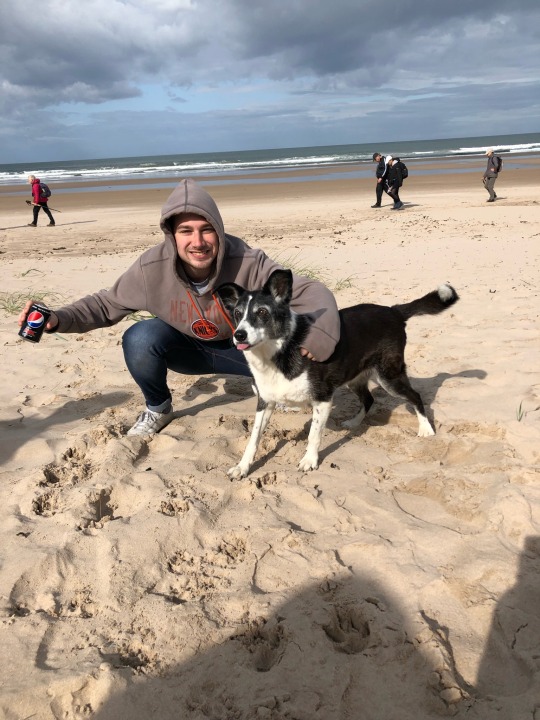
Dogs have played an important role in the history of human civilization and were among the first domesticated animals. They were important in hunter-gatherer societies as hunting allies and bodyguards against predators. When livestock were domesticated about 7,000 to 9,000 years ago, dogs served as herders and guardians of sheep, goats, and cattle. Although many still serve in these capacities, dogs are increasingly used for social purposes and companionship. Today dogs are employed as guides for the blind and disabled or for police work. Dogs are even used in therapy in nursing homes and hospitals to encourage patients toward recovery. Humans have bred a wide range of different dogs adapted to serve a variety of functions. This has been enhanced by improvements in veterinary care and animal husbandry.

Ancestry
Paleontologists and archaeologists have determined that about 60 million years ago a small mammal, rather like a weasel, lived in the environs of what are now parts of Asia. It is called Miacis, the genus that became the ancestor of the animals known today as canids: dogs, jackals, wolves, and foxes. Miacis did not leave direct descendants, but doglike canids evolved from it. By about 30 to 40 million years ago Miacis had evolved into the first true dog—namely, Cynodictis. This was a medium-size animal, longer than it was tall, with a long tail and a fairly brushy coat. Over the millennia Cynodictis gave rise to two branches, one in Africa and the other in Eurasia. The Eurasian branch was called Tomarctus and is the progenitor of wolves, dogs, and foxes.

The timing and location of dog domestication is less clear and has been a matter of significant debate, but there is strong genetic evidence that the first domestication events occurred somewhere in Central Asia before 15,000 years ago. Some genetic studies have suggested that wolves were domesticated 16,300 years ago to serve as livestock in China. Other genetic studies, however, have suggested that dog domestication began as early as 18,800–32,100 years ago in Europe or that early dogs dating from about 12,000 to 14,000 years ago came from a small strain of gray wolf that inhabited what is now India. Thereafter this wolf—known as Canis lupus pallipes—was widely distributed throughout Europe, Asia, and North America. However, one genetic study that compared the DNA of dogs and wolves inhabiting areas thought to have been centres of dog domestication suggests that dogs and modern wolves belong to separate lineages that share a common ancestor. It is also possible that some of the dogs of today descended not from the wolf but rather from the jackal. These dogs, found in Africa, might have given rise to some of the present native African breeds. A genetic study examining the migration of dogs to the Americas revealed evidence that dogs did not accompany the first humans to the New World more than 15,000 years ago; the study suggested that dogs came to the Americas only 10,000 years ago.

No matter what their origins, all canids have certain common characteristics. They are mammals that bear live young. The females have mammary glands, and they suckle their offspring. The early breeds had erect ears and pointed or wedge-shaped muzzles, similar to the northern breeds common today. Most of the carnivores have similar dental structures, which is one way paleontologists have been able to identify them. They develop two sets of teeth, deciduous (“baby”) teeth and permanent teeth.

It is likely that wild canids were scavengers near tribal campsites at the same time that ancient humans discovered a hunting partner in the animals that ventured close by. In ancient Egypt, dogs were thought to possess godlike characteristics. They were pampered by their own servants, outfitted with jeweled collars, and fed the choicest diet. Only royalty was permitted to own purebred dogs, and upon the death of a ruler his favourite dog was often interred with him to protect him from harm in the afterlife.

Illustrations of dogs dating from the Bronze Age have been found on walls, tombs, and scrolls throughout Europe, the Middle East, and North America. Often the dogs are depicted hunting game with their human counterparts. Statues of dogs guard the entrances to burial crypts. In many cases these dogs clearly resemble modern canines. Such relics are indelible testimony to the importance that humans have given to the dog throughout the ages.
Research from: https://www.britannica.com/animal/dog/Teeth
0 notes
Text
hyperborea was real.
and amerindians and europeans are spiritual and genetic brothers, both being descended from a common ancient north eurasian population.
it’s been a while since i’ve looked at my notes on the subject but the gist of it is this: some 20,000 years or so there was a “mammoth steppe” that stretched across eurasia, from the iberian peninsula to siberia and all the way into alaska. this mammoth steppe was abundant with life, especially megafauna like mammoths (hence, the name).

the red in this image represents increasing climactic suitability for the wooly mammoths. the green is decreasing suitability (though still theoretically suitable).
anyway, the remains of a boy were found in siberia, dated to about 24,000 years ago. they did genetic tests on him. turns out he is most genetically related to siberians, native americans, and yamnaya. yes, the yamnaya. the (theorized) progenitors of the indo-european language family that went on to conquer all of europe and a good chunk of asia. so this boy represents a population that is related to both native americans /and/ yamnaya (from which modern europeans are descended). this population is known as the “ancient north eurasians”.
so this population of ancient north eurasians (ane) came from somewhere (some say europe, some say middle east) and moved across the steppe into modern day siberia, probably following the mammoths. climate changed, food became more scarce, and a part of the population travelled west toward europe to become the yamnaya (after mixing with other populations -- but i’m not getting into that right now) and another part travelled east where they apparently mixed with an east asian population and migrated into the americas to become what we now know as native americans (generally speaking -- i know there were different waves of migration).
but beyond genetic connections there are also mythological connections. one mytheme that indo-europeans, siberians, and native americans have in common is that of the dog-guardian of the underworld and just generally an association between dogs and death and the underworld and healing or blessing. another myth common between all three peoples is the myth of the cosmic hunt. and even more than myth, i think there is some spiritual connection too. i think both native americans and yamnaya were restless, warlike, and noble steppe peoples.
#also something i found interesting while gathering my notes#is that apparently dogs have very negative associations in judaism and islam
20 notes
·
View notes
Link
Feral swine. Rodents of unusual size. And a python that swallowed three deer.
The history of invasive species is usually one of unforeseen consequences. When an animal, fish, insect or plant is taken out of its original ecosystem and introduced to a new one—whether by accident or on purpose—it's less likely to have any natural predators.
Which can lead to environmental havoc.
Without anything to keep their population in check, some invasive species—especially the prolific breeders—often flourish. They can destroy native plants, gobble up native animal populations and introduce disease, upending the delicate balance of organisms that provide food or support for each other, or provide a check on each other’s growth. Extinctions have proliferated.
Globalization has fueled the problem of invasive species. When European colonizers sailed to the Americas, they disrupted existing animal populations while also introducing new ones. Invading creatures have long affected the United States, as people imported new animals for study, sport, fur or even the love of Shakespeare. (Yes, really.) Here are seven invasive species that still pose a threat to the U.S. today.
READ MORE: How Burmese Pythons Took Over the Florida Everglades
1. FERAL SWINE (Sus scrofa)
Other names: Wild or feral boars, hogs or pigs; Eurasian or Russian wild boars
Originate from: Parts of Europe, Asia and North Africa
Reason in U.S.: European settlers brought them for food beginning in the 1500s; others brought them for sport hunting in the 1900s
Destructive superpowers: Devour crops and native vegetation
Newsworthy moment: Twitter's 2019 viral meme of '30 to 50 feral hogs'
The very real problem of invasive feral swine went viral in August 2019 when Twitter user @WillieMcNabb of Arkansas tweeted: “How do I kill the 30-50 feral hogs that run into my yard within 3-5 mins while my small kids play?” The phrase “30 to 50 feral hogs” quickly became a meme; and while it’s unlikely that many wild hogs actually run into McNabb’s yard at once, the discussion did highlight the growing issue of wild hogs in the U.S.
Feral swine are the same species as the pigs found on farms, and are descended from farm escapees and/or Eurasian or Russian wild boars brought to the U.S. for sport hunting in the 1900s. The U.S. Department of Agriculture estimates there are at least 6 million feral swine spread throughout some 35 states. They have been a particularly virulent problem throughout the south, especially in Texas, where their incessant rooting and voracious eating destroy crops, erode soil and uproot tree seedlings, causing deforestation. They also carry disease like pseudorabies and swine brucellosis. The U.S.D.A. estimates, conservatively, that invasive swine cause upward of $1.5 billion in damage annually to all manner of agriculture, including rice, corn and grains.
READ MORE: Bugs of War: How Insects Have Been Weaponized Throughout History
2. BURMESE PYTHONS (Python bivittatus)
Originate from: Southeast Asia
Reason in U.S.: Exotic pet trade
Destructive superpowers: Annihilating native small mammal populations
Newsworthy moments: Killed a two-year-old child; swallowed three deer
In 1979, staff members at Everglades National Park discovered Florida’s first recorded python, which was likely a Burmese python. By 2000, Florida was receiving reports of established populations of Burmese pythons in the state. These snakes, which can grow up to 20 feet long or more, were brought to Florida as part of the exotic pet trade. But many owners released the huge creatures, which reproduce rapidly; females are known to produce 50-100 eggs per year. With no predators on this continent, these slithery gluttons have since become a danger to native species, devouring more than 90 percent of small and medium-sized mammals in the Everglades. Some are more ambitious: One killed and swallowed three deer—a doe and two fawns—over a three-month period.
While not known to be a threat to humans, there have been isolated incidents. In 2009, a pet Burmese python broke out of its terrarium and strangled a two-year-old girl to death.
READ MORE: 9 Powerful Snakes from History and Mythology
3. DOMESTIC CATS (Felis catus)
Other names: feral cats, outdoor domestic cats
Originate from: North Africa and Southwest Asia
Reason in U.S.: European settlers brought them as pets
Destructive superpowers: Kill native birds and mammals
Newsworthy moment: Author Jonathan Franzen saying 'cats must die'
Cats are a beloved pet in the U.S., which is why it comes as such a shock to many Americans that they are seen as a destructive invasive species here as well as in the U.S. and many other parts of the world. Historians believe ancient Egyptians were the first to domesticate cats, and that these pets spread to Europe during the Roman Empire. When Europeans colonized North America, they brought cats with them as pets.
Since then, these animals have flourished while harming native species. In 2013, a paper in Nature Communications estimated “free-ranging domestic cats kill 1.3–4.0 billion birds and 6.3-22.3 billion mammals annually.” And the American Bird Conservancy estimates that cats have contributed to the extinction of more than 60 species of birds, mammals and reptiles. Author and bird lover Jonathan Franzen, for one, has drawn criticism for his statements on this issue. Back in 2013, he told New York magazine: “The bird community’s position is, we need to get rid of the feral cats, and that means cats must die.”
4. EUROPEAN STARLINGS (Sturnus vulgaris)
Other names: Common starling, English starling
Originate from: Parts of Europe, Asia and Africa
Reason in U.S.: A Shakespeare fan went too far
Destructive superpowers: Destroy crops
Newsworthy moment: In 1960, a swarm of 10,000 starlings flew into a passenger plane taking off from Boston’s Logan Airport, disabling the engines and causing a crash that killed 62 people.
Eugene Schieffelin was such a fan of William Shakespeare that he decided to introduce a bird mentioned in his play Henry IV into the U.S. In 1890 and 1891, Schieffelin unleashed approximately 100 imported Europeans starlings into New York City’s Central Park.
Bad idea.
Within 50 years, they had spread across the continent. Today, there are more than 200 million European starlings in North America; considered noxious and destructive, they compete with native species and destroy crops such as grains and pitted fruits. They swarm agricultural feeding troughs, contaminating food and water, and their droppings are associated with diseases ranging from histoplasmosis, a lung ailment afflicting agricultural workers, to toxoplasmosis, which can be particularly harmful to pregnant women.
5. NUTRIA (Myocastor coypus)
Other names: Coypu, swamp rats, river rats
Originate from: South America
Reason in U.S.: Brought for fur trade
Destructive superpowers: Damage crops and natural resources
Newsworthy moment: A Louisiana hunter, likely incentivized by the state's $6-per-tail bounty on the swamp rats, handed in nearly 11,000 tails to the 2019 nutria culling program.
Described by some as a cross between a beaver and a sewer rat, with large orange buck teeth, nutria can grow as large as 20 pounds. They came to Louisiana in the early part of the 20th century as part of the fur trade, but as the market declined, traders released them into the wild, where they have wreaked havoc and spread to each coast. They not only damage crops and other property; they gnaw prodigiously through wetland plants, causing significant soil erosion and turning swamps into open waters; their extensive burrow systems can destabilize roads, bridges, levees and golf courses; and they can transmit diseases like tuberculosis.
California actually eradicated nutria in the 1970s, only to discover them again in the state’s San Joaquin Valley in 2017. Since then, California has relaunched efforts to eliminate these rodents, which can be prolific breeders.
6. ASIAN CARP (multiple species)
Originate from: Different parts of Asia
Reason in U.S.: Introduced into the U.S. in the 1970s to help keep fish farms clean
Destructive superpowers: Out-compete native fish for food and habitat
Newsworthy moment: Wildlife authorities cautioning against massive carp leaping into people’s boats
In the U.S., there are four invasive species collectively known as “Asian carp”: bighead carp, black carp, grass carp and silver carp. In the 1970s, the U.S. imported them to help keep aquatic farms clean, control weeds in canal systems and help with sewage treatment. However, they escaped into the Mississippi River basin, scarfing up the base of the aquatic food chain, with some species eating as much as 20 to 100 percent of their body weight daily. They have been outbreeding native species and pushing them out of their own ecosystem, while expanding into new waterways. Silver carp, which have a disconcerting habit of leaping out of the water, have been seen as a hazard to boaters and anglers.
7. GYPSY MOTHS (Lymantria dispar)
Originate from: Europe and Asia
Reason in U.S.: French artist and astronomer accidentally let them loose
Destructive superpowers: Strip trees of leaves and make them vulnerable to disease
Newsworthy moment: Defoliated more than 2 million acres in three years alone
French artist and astronomer Étienne Léopold Trouvelot first brought gypsy moths to the U.S. in the late 1860s to see if they could produce textiles better than silkworms. Unfortunately, they blew out of the building he was living in near Boston—oops!—and spread into the Massachusetts countryside. From there, the voracious gypsy moths, which appear initially as spiky caterpillars, have spread throughout the northeastern U.S., threatening more than 300 species of trees and shrubs, reducing animal habitats and presenting an increased fire hazard. They are particularly fond of oak trees.
They’re also an expensive pest to deal with: Between 1980 and 1994 alone, the U.S. spent an average of $30 million annually on gypsy moth eradication, suppression and research.
Swamp People: Serpent Invasion premieres Thursday, March 12 at 10/9c.
from Stories - HISTORY https://ift.tt/2PjU1Xg February 25, 2020 at 03:37AM
0 notes
Text
Day Two - Wander
I drove for hours into the middle of nowhere today. I drove to the edge of farmland marked with “No trespassing” signs and parked off the side of the road. Leaving my car and ignoring the signs, I hopped the fence and walked through knee high grass, unsure of my destination.
I hadn’t planned the trip. I’ve known for awhile that there were sights hidden in the midwest farmland, but a five hour drive to see a few rocks never seemed worth it. Today, however, I felt restless. I felt the need to venture out into the world.
You see the tattoos all the time. “Wanderlust”, “Not all who wander are lost”, “Wanderer”, etc. The word Wander has some poetry within its six letters. It calls to something innate within us. Some holdout from the lives of our nomadic ancestors. There’s a desire to keep moving, to find somewhere new. As time moves on we begin to feel that we must move as well.
The word began more than 7000 years ago. Speakers of a language known as Proto-Indo-European lived on the Eurasian steppes. They moved on foot, from camp to camp. And while some followed set paths, others broke out on their own. These pioneers were mocked by the others for not following the straight path of the others, but choosing instead to move without direction. They used the word wendh, meaning to wind or weave.
While walking different paths was enough at first, there was more of the world to explore. So these Eurasian nomads domesticated the wild horses of the steppes, giving them a way to move farther and faster. They began spreading out from their homeland, further and further away, in all directions. Many moved into Asia, their descendants are the speakers of languages like Hindi and Sanskrit. Others moved into southern Europe, leading to Italian, Greek and countless others. Still more pushed farther and farther north, carrying the word for the winding path with them.
The languages changed and shifted, and the word changed with it. 2200 years ago, in the first and second century BCE, the word had grown and shifted to wandran. Still those that had traveled from their homeland, from Urheimat on the steppes, pressed on. They built boats and sailed to islands in the Atlantic, and again their language shifted. In the 4th century CE, speakers of Old English looked at those who refused to settle down, to remain in one place, and used the word wandrian. For the first time the word captured the oddity of wandering. Translated it means “to move about aimlessly.” The speakers of Old English understood that when one wanders, they do so with no destination in mind, no assurance that there will be an end to their journey.
The heroes in the oldest tales of the english language, when they find themselves at a crossroads, often wander, seeking some sign or direction. As we move closer to modern English, we see the word change to wandren, and finally wander in the 16th century CE. And that’s how it has stayed. The main difference now is that we have been applying it to a class of people. Wanderers.
For the most part I’m sedentary. My ancestors came and settled on farms, 3000 miles from their homeland was far enough, and that desire to finally put down roots has taken a few generations to wear off. Every so often, I have the desire to move off the path I’m on, to wander.
Today, I trudge through a fallow field, still soaked from the weekend’s rainstorm. As I come over a ridge I see below me a line of rock formations, formed eons before my ancestors ever left their home on the steppes. They are arranged in no set pattern, the ancient sea that once covered the Great Plains had eroded them, leaving pocks and craters, holes and cracks. They rise out of the plains like a god’s discarded dentures. I don’t hike to them. I just stare for awhile, before continuing on, wandering aimlessly.
0 notes
Text
Cap 147 : Culturas de Rusia : Ancestros de Paleoindios : Mal'ta–Buret
.
El Niño de Mal'ta del Capítulo anterior fue enterrado con Respeto y Amor y se le dió un hermoso Ajuar Funerario, costoso para su Epoca, hace 24000 Años. Ver en la segunda Imagen los Objetos acompañantes para el Viaje en el Otro Mundo.
.
*******************************
,
Primera Imagen :
La Flecha Verde son los Ancestros de los Europeos, la Flecha lleva a muchos Pueblos incluídos los Yamnayas o Kurgans sobre el Mar Negro y Ancestros de los Pueblos Indo Europeos que incluyen a casi toda Europa.
La Flecha Verde pasa por una Bola Negra . En ese Círculo Negro se cruzan con la Flecha Roja que son los Asiáticos como los Chinos y Japoneses y se casan y fertilizan cruzando sexualmente sus Genes Europeos y Orientales.
Es demasiado Aventurado decir que ese fue el Sitio donde se cruzaron las dos Culturas y Etnias distintas. Me parece que eligieron un Sitio cercano a la Aldea de Mal'ta y el Lago Baikal por Facilismo, pero no deja de ser Especulación. No había Periodistas con Video Cámaras, ni Notarios cuando ocurrieron estos Coitos entres los Proto-Europeos y los Proto-Asiáticos ( o mejor Proto-Siberianos actuales ? ). Dejemos todo en la Duda Científica !.
El Cruce produce una Flecha Morada y Círculo Morado que va a Beringia a producir los Paleoindios o sea la primera Ola que llega a América desde Asia pasando por Beringia ( en color Verde ).
El Niño de Anzick en Montana USA de 12,600 Años de Antiguedad es otro Descubrimiento Genético sensacional gigantesco en la PaleoGenética y ArqueoGenética, y muestra que la Hipótesis Solutrean de Europeos llegando por el Atlántico va perdiendo Piso Día a Día.
.
Para ver la Imagen mucho mas grande ábrala en una Pestaña nueva de Windows con el Mouse Botón derecho y la ve muy aumentada.
,

.
*******************************
.
El estudio de los restos de un joven de la aldea siberiana de Mal'ta, de 24.000 años de antigüedad, ha añadido una nueva raíz al árbol genealógico de los indígenas americanos. Mientras que algunos vienen claramente del este de Asia, el genoma del chico de Mal'ta (el humano moderno más antiguo) muestra que hasta un tercio de esa ascendencia es europea.
Los resultados muestran que las personas relacionadas con eurasiáticos occidentales se habían extendido más al este de lo que nadie había sospechado y vivieron en Siberia durante las partes más frías de la última Edad de Hielo.
"En algún momento en el pasado, una rama de los asiáticos orientales y una sucursal de eurasiáticos occidentales se conocieron y tuvieron relaciones sexuales", señala el paleontólogo Eske Willerslev. "Esta mezcla creó a los nativos americanos, en el sentido de que fueron los predecesores de las poblaciones que posteriormente llegaron a América, tanto al norte como al sur".
Cultura, Identidad y PatrimonioLos indígenas americanos tienen raíces europeas. Por Prensa ICL 21/11/13
http://institutoculturaldeleon.org.mx/icl/story/1095/Los-ind-genas-americanos-tienen-ra-ces-europeas#.YM_TMGgza1s
.
*******************************
.

.
Scientists have mapped the genome of a four-year-old boy who died in south-central Siberia 24,000 years ago.
.......
They suggest about a third of Native American ancestry came from an ancient population related to Europeans.
.................
The burial of an Upper Palaeolithic Siberian boy was discovered along with numerous artefacts in the 1920s by Russian archaeologists near the village of Mal'ta, along the Belaya river.
"With these remains of a young kid were all sorts of cultural items, one of which was a Venus figurine,".
............
"When we sequenced this genome, something strange appeared," he explained. "Parts of the genome you find today in western Eurasians, other parts of the genome you find today in Native Americans - and are unique today to Native Americans."
DNA from the boy's Y chromosome and from the mitochondria (the cell's batteries) were of types found today in a region encompassing Europe, West and South Asia and North Africa, but rare or absent in Central Asia, East Asia and the Americas.
The researchers estimate that 14-38% of the ancestry of Native Americans traces to a population like the one living at Mal'ta 24,000 years ago.
But the most puzzling part of this finding was that the boy showed no clear affinities with East Asian populations such as the Chinese, Koreans or Japanese.
.
Ancient DNA from Siberian boy links Europe and AmericaPublished20 November 2013
https://www.bbc.com/news/science-environment-25020958
.
********************************
.
Of the 24,000 year-old skeleton that was Exhibit A, Willerslev was quoted in THE SIBERIAN TIMES, as saying, “His DNA shows close ties to those of today’s Native Americans. Yet he apparently descended not from East Asians, but from people who had lived in Europe or western Asia.” He added, “The finding suggests that about a third of the ancestry of today’s Native Americans can be traced to ‘western Eurasia.‘”
The 4-year-old boy, who died 24,000 years ago in a homeland previously assumed to account for all the Indians who crossed a theoretical Bering land-bridge and founded the First Americans, had a male Y-chromosomal haplogroup of R1b, the most common lineage in modern Europe, and a female mitochondrial lineage of U, the dominant prototype in pre-historic Europe. As it happens, I am the same combination, R1b for male and U for female, as are innumerable others in our in-house study on CHEROKEE DNA, published, lo, some five years ago.
Whereas previous “peopling of the Americas” stuff has clung to and recycled haplogroup studies (sex-lines), the new shock research relies on autosomal DNA, total genomic contributions from all ancestral lines, not just male-only, not just female-only descent. The title of a blog from Eurogenes rightly emphasizes this: “Surprising aDNA [autosomal] results from Paleolithic Siberia (including Y DNA R).”
When we introduced the 18-MARKER ETHNIC PANEL as an enhancement for our main autosomal product, DNA Fingerprint Plus, lo, again, these five years now and counting, we presented a map of prehistoric human migrations showing without any equivocation that “Native Americans,” even as Cavalli-Sforza demonstrated two decades ago, were closer in genetic distance to Europeans than Asians. In fact, we claimed, on the basis of autosomal DNA, that having Native American I or Native American II was a result discrete and separate from East Asian, since Native Americans obtained frequencies of its occurrence as high as 80% and Asians were on the polar opposite of the scale, at the bottom for carrying it. Other methods frequently confused Native American and East Asian to the point of invalidity, particularly those products claiming to arrive at racial or ethnic percentages.
The moral is that autosomal DNA trumps Y chromosome and mitochondrial evidence, and only ancient autosomal DNA can truly explain modern DNA.
.
Fuente : NATIVE AMERICANS HAVE DEEP ANCESTRY IN EUROPE - Shocking, Long Overdue Revision to American Indian Genetics
By Donald N. Yates - October 2013
https://dnaconsultants.com/native-americans-deep-ancestry-europe-yes-official/
.
********************************
.
Pintura de Frank Weir
Un Enterramiento de un miembro de la Tribu Paleoindia hace Miles de Años. Un Shamán hace sonar Instrumentos de Ruido. Puedes abrir la Imagen en una Pestaña nueva de Windows para verla mas en Detalle.
,

,
Detalle de la Pintura Anterior : Un Miembro de la Tribu deposita con Amor y Respeto el Ajuar Funerario que acompaña al Muerto en el Otro Mundo.
.

.
Some 11,000 years ago, the bodies of a man and a child were laid together in a shallow pit beneath the broad overhang of Horn Shelter.
.
Horn Shelter - A Paleoindian Grave
https://www.texasbeyondhistory.net/horn/burials.html
.
********************************
.

.
********************************
,
Después de sufrir mucho Frío, mucha Nieve y Hielo, los Paleoindios van hacia el Sur dentro de Norte América y llegan a un Sitio primaveral donde hay mucha Vegetación y Animales para cazar.
.

.
.
1 note
·
View note